Paul van Yperen's Blog, page 269
June 9, 2018
Deborah Kerr
Stage, television and film actress Deborah Kerr (1921-2007) was nicknamed 'The English Rose' for her fresh natural beauty. In many films, the Scottish-born film star played 'classic' English ladies, but during the 1950s she became known for her versatile roles in popular Hollywood productions.
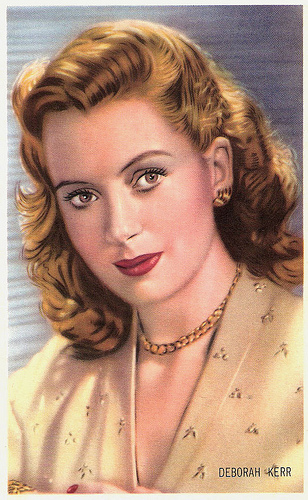
Belgian collectors card by Kwatta, Bois-d'Haine, no. C. 199. Photo: MGM.
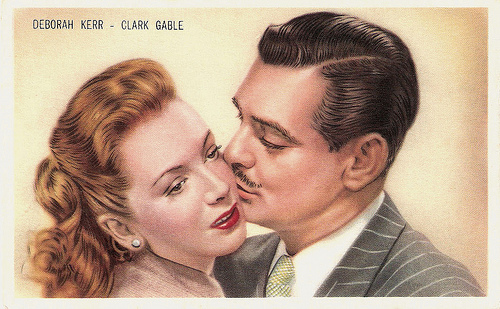
Belgian collectors card by Kwatta, Bois-d'Haine, no. C. 223. Photo: MGM. Publicity still for The Hucksters (Jack Conway, 1947) with Clark Gable.
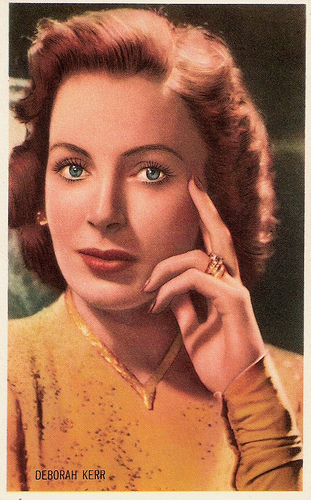
Belgian collectors card by Kwatta, Bois D'Haine, no. C. 252.
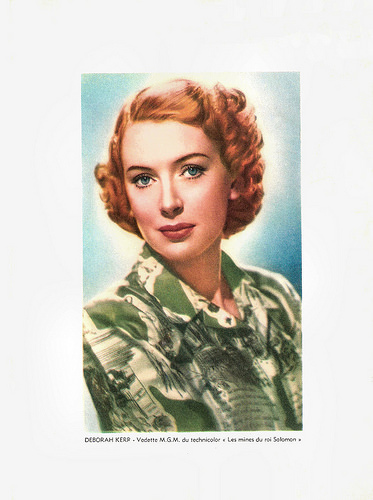
Belgian collectors card. Photo: MGM. Publicity still for King Solomon's Mines (Compton Bennett, Andrew Marton, 1950).
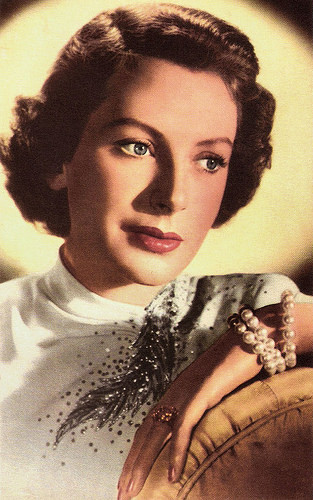
Belgian collectors card by Kwatta, Bois-d'Haine, no. C. 363. Photo: publicity still for The Prisoner of Zenda (Richard Thorpe, 1952).
Shy and Insecure Child
Deborah Kerr was born as Deborah Jane Kerr-Trimmer in 1921, Helensburgh, Scotland. She was the daughter of Captain Arthur Kerr-Trimmer, a World War I veteran pilot, who became a naval architect and civil engineer, and his wife Kathleen Rose Smale.
A shy, insecure child, Deborah found an outlet for expressing her feelings in acting. Her aunt Phyllis Smale, a radio star and director of the Hicks-Smale Drama School in Bristol, became her first acting coach.
Her aunt got her some stage work when she was a teenager. Deborah first performed at the Open Air Theatre in Regent's Park, London. She subsequently performed with the Oxford Repertory Company in 1939-1940.
Her first appearance on the West End stage was as Ellie Dunn in Heartbreak House at the Cambridge Theatre in 1943.
She performed in France, Belgium and Holland with ENSA (Entertainments National Service Association, or Every Night Something Awful) - The British Army entertainment service.
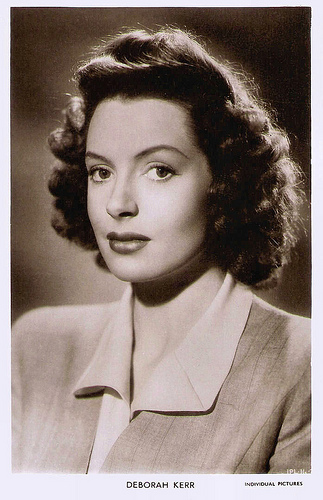
British postcard in the Picturegoer Series, no. W. 213. Photo: Individual Pictures. Publicity still for I See a Dark Stranger/The Adventuress (Frank Launder, 1946).
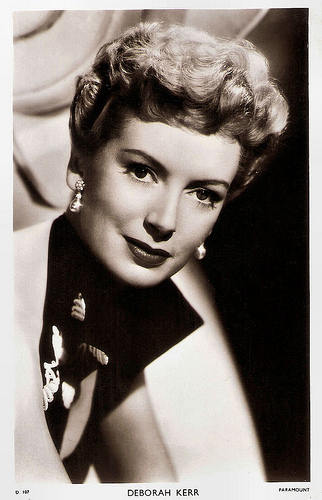
British postcard in the Picturegoer series, London, no. D 107. Photo: Paramount.
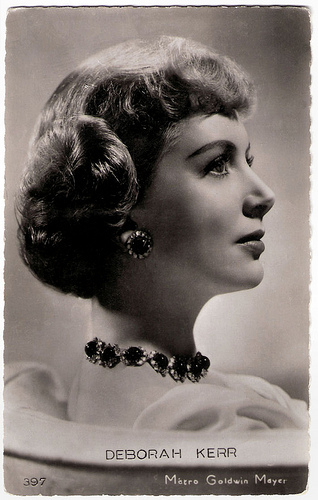
French postcard by Editions P.I., Paris, no. 397. Photo: Metro-Goldwyn-Mayer.
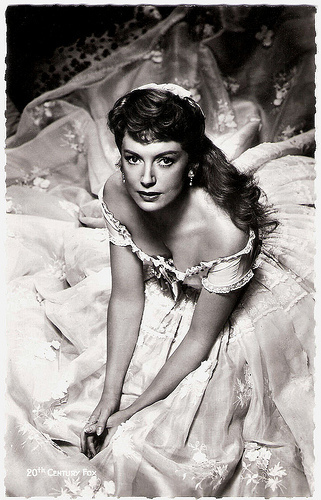
French postcard by Editions du Globe, no. 538. Photo: International Press.
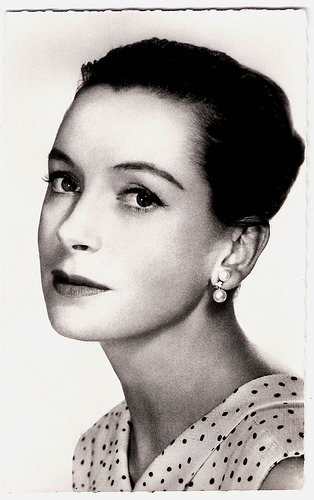
French postcard by Editions du Globe, Paris, no. 663.
Women Who Stumble Sexually
Deborah Kerr's first film appearance was a small role in Contraband (Michael Powell, Emeric Pressburger, 1940), but her scenes were deleted.
British film producer Gabriel Pascal noticed and cast her in his film of George Bernard Shaw's Major Barbara (1941) as Jenny Hill, a girl of the salvation army.
Her wonderfully fresh natural beauty and incisiveness of playing were on show in Love on the Dole (John Baxter, 1941) and Hatter's Castle (Lance Comfort, 1941), in both as women who stumble sexually, by altruistic design in the former, through heartless seduction in the latter.
Michael Powell made her a major star of the British cinema by giving her the triple role of the hero’s three women in The Life and Death of Colonel Blimp (Michael Powell, Emeric Pressburger, 1943).
Next she played the dowdy wife who blossoms in wartime in Perfect Strangers (Alexander Korda, 1945), and the assertive Irish spy in I See a Dark Stranger (Frank Launder, 1946).
Then Powell cast her unforgettably as Sister Clodagh, forced to confront her own repressions in the Himalayan setting of Black Narcissus (Michael Powell, Emeric Pressburger, 1947). The film was a hit in the US as well as the UK, and Kerr won the New York Film Critics' Award as Actress of the Year.
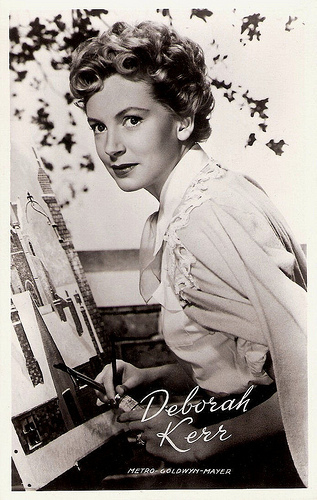
Dutch postcard by Takken, Utrecht, no. 960. Photo: Metro-Goldwyn-Mayer.
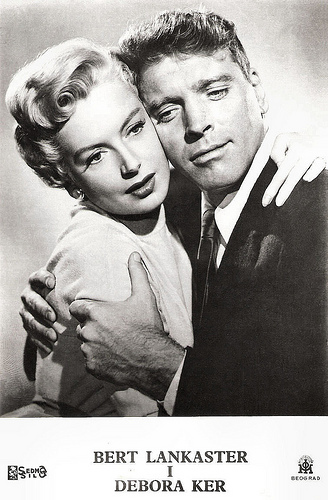
Yugoslavian postcard by IOM, Beograd. Photo: Sedmo Silo. Deborah Kerr and Burt Lancaster in From Here to Eternity (Fred Zinnemann, 1953).
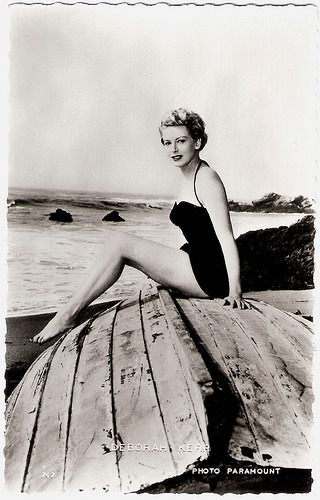
French postcard by Editions P.I., offered by Les Carbones Korès Carboplane, no. 747. Photo: Paramount.
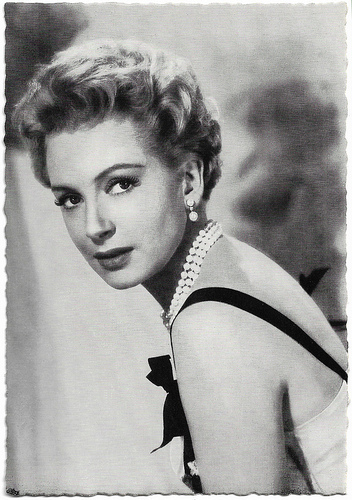
German postcard by WS-Druck, Wanne-Eickel, no. 279. Photo: Archiv Filmpress Zürich.
Kerr rhymes with Star!
In 1947, Deborah Kerr went to Hollywood. Her surname was pronounced there as "car", not "kerr" In order to avoid confusion over pronunciation, Louis B. Mayer billed her as "Kerr rhymes with Star!"
She repeated for MGM her success in films like The Hucksters (Jack Conway, 1947) opposite Clark Gable, Edward, My Son (George Cukor, 1949) and the historical epic Quo Vadis (Mervyn Le Roy, 1951).
For her role as the wife who falls into dipsomania (a medical condition involving an uncontrollable craving for alcohol) in Edward, My Son, she was both nominated for a Golden Globe and an Academy Award, but won neither.
After a while she tired of playing prim-and-proper British ladies. “I came over here (Hollywood) to act, but it turned out all I had to do was to be high-minded, long suffering, white-gloved and decorative”, she was quoted.
Then came an opportunity to expand with From Here to Eternity (Fred Zinnemann, 1953). Originally Joan Crawford was meant to play the adulterous military wife who has an affair with Burt Lancaster , but when Crawford insisted on shooting the film with her own cameraman, the studio balked.
They decided to take a chance and cast Deborah Kerr, who made the most of the adulteress who makes love with Burt Lancaster on a Hawaii beach amidst the crashing waves. The casting worked, the film was a success, and Kerr received her second Oscar nomination.
And her career thereafter enjoyed a new, sexier versatility. She was quoted: “I don't think anyone knew I could act until I put on a bathing suit”.
In 1953, she also achieved success on the Broadway stage in Tea and Sympathy, reprising her role in the film version Tea and Sympathy (Vincente Minnelli, 1956).
That same year, she played one of her best-remembered screen roles, Mrs. Anna Leonowens in the Rodgers and Hammerstein musical The King and I (Walter Lang, 1956), although her singing voice in the film was dubbed by Marni Nixon.
More success followed in Heaven Knows, Mr. Allison (John Huston, 1957), An Affair to Remember (Leo McCarey. 1957) with Cary Grant, Separate Tables (Delbert Mann, 1958), The Sundowners (Fred Zinnemann, 1960), The Innocents (Jack Clayton, 1961) and The Night of the Iguana (John Huston, 1964).
Originally when filming began on Heaven Knows, Mr. Allison (1957), her co-star Robert Mitchum worried that Kerr would be like the prim characters she frequently played. However, after she swore at director John Huston during one take, Mitchum, who was in the water, almost drowned laughing. The two stars went on to have an enduring friendship which lasted until Mitchum's death in 1997.
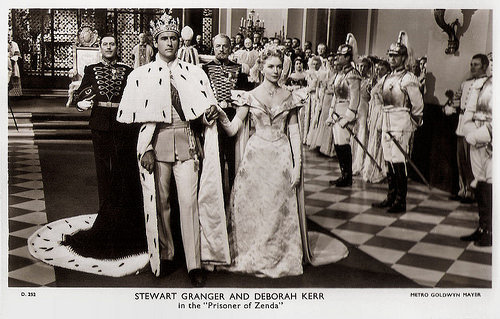
British postcard on the Picturegoer Series, London, no. D 252. Photo: Metro-Goldwyn-Mayer. Publicity still for The Prisoner of Zenda (Richard Thorpe, 1952) with Stewart Granger .
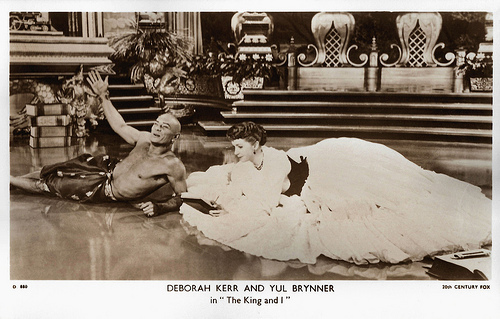
British postcard in the Picturegoer Series, London, no. D 880. Photo: 20th Century Fox. Publicity still for The King and I (Walter Lang, 1956) with Yul Brynner .
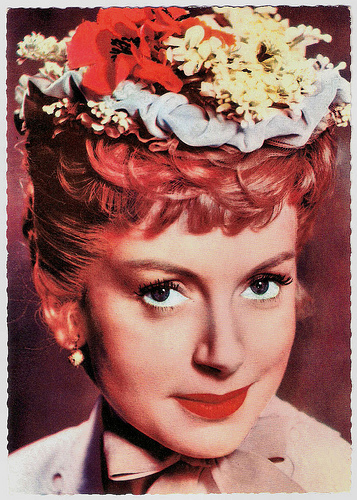
West-German postcard by ISV, no. A 55. Photo: 20th Century Fox. Publicity still for The King and I (Walter Lang, 1956).
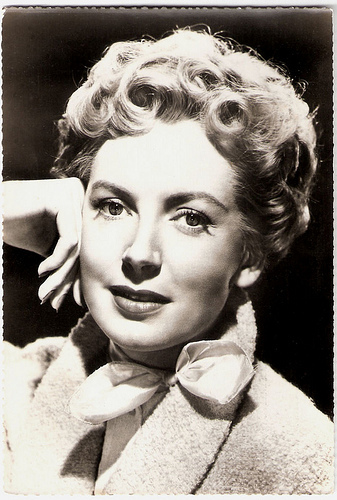
German postcard by WS-Druck, Wanne-Eickel, no. 279. Photo: Archiv Filmpress Zürich.
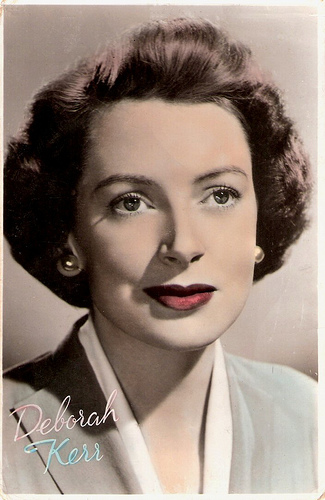
Dutch postcard. Photo: MGM.
The oldest 'Bond Girl'
In 1967, at the age of 46, Deborah Kerr starred in Casino Royale (Val Guest a.o., 1967), achieving the distinction of being the oldest 'Bond Girl' in any James Bond film.
In 1968, pressure of competition from younger, upcoming actresses made her agree to appear nude in John Frankenheimer's The Gypsy Moths, the only nude scene in her career. Then, in 1968, Deborah Kerr suddenly quit films, appalled by the explicit sex and violence of the day.
She did swan song performances as the prickly memsahib adjusting to the home counties in her last film, The Assam Garden (Mary McMurray, 1985), and as the older version of the female tycoon, Emma Harte, in the TV adaptation of Barbara Taylor Bradford's A Woman of Substance (Don Sharp, 1984). After Hold the Dream (Don Sharp, 1986), the two-part, four-hour followup to A Woman of Substance, she retired from acting altogether.
For her performance in A Woman of Substance, Kerr was nominated for an Emmy Award. In 1984, she was awarded a Cannes Film Festival Tribute. Deborah Kerr holds the record of the most Oscar nominations (six) without a win, but that was made up for in 1994, when she was given a Honorary Oscar for her screen achievements. It was to be her last public appearance.
Similar to her losing streak at the Oscars, Deborah was finally awarded a BAFTA Special Award in 1991 after being nominated four times. She did, however, win the New York Film Critics Award three times and the Golden Globe Award for The King and I (1956). She was made a Fellow of the British Film Institute in recognition of her outstanding contribution to film culture. And she was awarded a CBE (Commander of the Order of the British Empire) in the 1998.
Deborah Kerr died from complications from Parkinson's disease in 2007, in Botesdale, England. She lived in Switzerland and Spain after retiring from acting, but returned to England to be with her family when her Parkinson's disease worsened.
She was married twice. First to Royal Air Force squadron leader Anthony C. Bartley (1945-1959) with whom she had two daughters, Melanie Jane and Francesca Ann. In 1960, after her divorce, she married to Hollywood screenwriter Peter Viertel. The couple stayed together till her death. She is mother-in-law of actor John Shrapnel, who married her daughter Francesca. She is thus also the grandmother of writer Joe Shrapnel and actors Lex Shrapnel and Tom Shrapnel.
Scenes from The Life and Death of Colonel Blimp (1943). Source: The Film Foundation. The Life and Death of Colonel Blimp was restored by the Academy Film Archive in association with the BFI National Archive, ITV Studios Global Entertainment Ltd., and The Film Foundation. Powell and Pressburger’s magnificent epic was heavily cut for various reissues and even shown in black-and-white over the years, making it all the more vital that the film was restored in all its Technicolor glory.
Trailer for Black Narcissus (1947). Source: ryy79 (YouTube).
The famous scene on the beach in From Here to Eternity (1953). Source: Rowsdower ! (YouTube).
Trailer for The Innocents (1961). Source: PurpleGardenWalls (YouTube).
Sources: Brian McFarlane (Encyclopedia of British Film), (IMDb), (IMDb), Wikipedia, and .

Belgian collectors card by Kwatta, Bois-d'Haine, no. C. 199. Photo: MGM.

Belgian collectors card by Kwatta, Bois-d'Haine, no. C. 223. Photo: MGM. Publicity still for The Hucksters (Jack Conway, 1947) with Clark Gable.

Belgian collectors card by Kwatta, Bois D'Haine, no. C. 252.

Belgian collectors card. Photo: MGM. Publicity still for King Solomon's Mines (Compton Bennett, Andrew Marton, 1950).

Belgian collectors card by Kwatta, Bois-d'Haine, no. C. 363. Photo: publicity still for The Prisoner of Zenda (Richard Thorpe, 1952).
Shy and Insecure Child
Deborah Kerr was born as Deborah Jane Kerr-Trimmer in 1921, Helensburgh, Scotland. She was the daughter of Captain Arthur Kerr-Trimmer, a World War I veteran pilot, who became a naval architect and civil engineer, and his wife Kathleen Rose Smale.
A shy, insecure child, Deborah found an outlet for expressing her feelings in acting. Her aunt Phyllis Smale, a radio star and director of the Hicks-Smale Drama School in Bristol, became her first acting coach.
Her aunt got her some stage work when she was a teenager. Deborah first performed at the Open Air Theatre in Regent's Park, London. She subsequently performed with the Oxford Repertory Company in 1939-1940.
Her first appearance on the West End stage was as Ellie Dunn in Heartbreak House at the Cambridge Theatre in 1943.
She performed in France, Belgium and Holland with ENSA (Entertainments National Service Association, or Every Night Something Awful) - The British Army entertainment service.

British postcard in the Picturegoer Series, no. W. 213. Photo: Individual Pictures. Publicity still for I See a Dark Stranger/The Adventuress (Frank Launder, 1946).

British postcard in the Picturegoer series, London, no. D 107. Photo: Paramount.

French postcard by Editions P.I., Paris, no. 397. Photo: Metro-Goldwyn-Mayer.

French postcard by Editions du Globe, no. 538. Photo: International Press.

French postcard by Editions du Globe, Paris, no. 663.
Women Who Stumble Sexually
Deborah Kerr's first film appearance was a small role in Contraband (Michael Powell, Emeric Pressburger, 1940), but her scenes were deleted.
British film producer Gabriel Pascal noticed and cast her in his film of George Bernard Shaw's Major Barbara (1941) as Jenny Hill, a girl of the salvation army.
Her wonderfully fresh natural beauty and incisiveness of playing were on show in Love on the Dole (John Baxter, 1941) and Hatter's Castle (Lance Comfort, 1941), in both as women who stumble sexually, by altruistic design in the former, through heartless seduction in the latter.
Michael Powell made her a major star of the British cinema by giving her the triple role of the hero’s three women in The Life and Death of Colonel Blimp (Michael Powell, Emeric Pressburger, 1943).
Next she played the dowdy wife who blossoms in wartime in Perfect Strangers (Alexander Korda, 1945), and the assertive Irish spy in I See a Dark Stranger (Frank Launder, 1946).
Then Powell cast her unforgettably as Sister Clodagh, forced to confront her own repressions in the Himalayan setting of Black Narcissus (Michael Powell, Emeric Pressburger, 1947). The film was a hit in the US as well as the UK, and Kerr won the New York Film Critics' Award as Actress of the Year.

Dutch postcard by Takken, Utrecht, no. 960. Photo: Metro-Goldwyn-Mayer.

Yugoslavian postcard by IOM, Beograd. Photo: Sedmo Silo. Deborah Kerr and Burt Lancaster in From Here to Eternity (Fred Zinnemann, 1953).

French postcard by Editions P.I., offered by Les Carbones Korès Carboplane, no. 747. Photo: Paramount.

German postcard by WS-Druck, Wanne-Eickel, no. 279. Photo: Archiv Filmpress Zürich.
Kerr rhymes with Star!
In 1947, Deborah Kerr went to Hollywood. Her surname was pronounced there as "car", not "kerr" In order to avoid confusion over pronunciation, Louis B. Mayer billed her as "Kerr rhymes with Star!"
She repeated for MGM her success in films like The Hucksters (Jack Conway, 1947) opposite Clark Gable, Edward, My Son (George Cukor, 1949) and the historical epic Quo Vadis (Mervyn Le Roy, 1951).
For her role as the wife who falls into dipsomania (a medical condition involving an uncontrollable craving for alcohol) in Edward, My Son, she was both nominated for a Golden Globe and an Academy Award, but won neither.
After a while she tired of playing prim-and-proper British ladies. “I came over here (Hollywood) to act, but it turned out all I had to do was to be high-minded, long suffering, white-gloved and decorative”, she was quoted.
Then came an opportunity to expand with From Here to Eternity (Fred Zinnemann, 1953). Originally Joan Crawford was meant to play the adulterous military wife who has an affair with Burt Lancaster , but when Crawford insisted on shooting the film with her own cameraman, the studio balked.
They decided to take a chance and cast Deborah Kerr, who made the most of the adulteress who makes love with Burt Lancaster on a Hawaii beach amidst the crashing waves. The casting worked, the film was a success, and Kerr received her second Oscar nomination.
And her career thereafter enjoyed a new, sexier versatility. She was quoted: “I don't think anyone knew I could act until I put on a bathing suit”.
In 1953, she also achieved success on the Broadway stage in Tea and Sympathy, reprising her role in the film version Tea and Sympathy (Vincente Minnelli, 1956).
That same year, she played one of her best-remembered screen roles, Mrs. Anna Leonowens in the Rodgers and Hammerstein musical The King and I (Walter Lang, 1956), although her singing voice in the film was dubbed by Marni Nixon.
More success followed in Heaven Knows, Mr. Allison (John Huston, 1957), An Affair to Remember (Leo McCarey. 1957) with Cary Grant, Separate Tables (Delbert Mann, 1958), The Sundowners (Fred Zinnemann, 1960), The Innocents (Jack Clayton, 1961) and The Night of the Iguana (John Huston, 1964).
Originally when filming began on Heaven Knows, Mr. Allison (1957), her co-star Robert Mitchum worried that Kerr would be like the prim characters she frequently played. However, after she swore at director John Huston during one take, Mitchum, who was in the water, almost drowned laughing. The two stars went on to have an enduring friendship which lasted until Mitchum's death in 1997.

British postcard on the Picturegoer Series, London, no. D 252. Photo: Metro-Goldwyn-Mayer. Publicity still for The Prisoner of Zenda (Richard Thorpe, 1952) with Stewart Granger .

British postcard in the Picturegoer Series, London, no. D 880. Photo: 20th Century Fox. Publicity still for The King and I (Walter Lang, 1956) with Yul Brynner .

West-German postcard by ISV, no. A 55. Photo: 20th Century Fox. Publicity still for The King and I (Walter Lang, 1956).

German postcard by WS-Druck, Wanne-Eickel, no. 279. Photo: Archiv Filmpress Zürich.

Dutch postcard. Photo: MGM.
The oldest 'Bond Girl'
In 1967, at the age of 46, Deborah Kerr starred in Casino Royale (Val Guest a.o., 1967), achieving the distinction of being the oldest 'Bond Girl' in any James Bond film.
In 1968, pressure of competition from younger, upcoming actresses made her agree to appear nude in John Frankenheimer's The Gypsy Moths, the only nude scene in her career. Then, in 1968, Deborah Kerr suddenly quit films, appalled by the explicit sex and violence of the day.
She did swan song performances as the prickly memsahib adjusting to the home counties in her last film, The Assam Garden (Mary McMurray, 1985), and as the older version of the female tycoon, Emma Harte, in the TV adaptation of Barbara Taylor Bradford's A Woman of Substance (Don Sharp, 1984). After Hold the Dream (Don Sharp, 1986), the two-part, four-hour followup to A Woman of Substance, she retired from acting altogether.
For her performance in A Woman of Substance, Kerr was nominated for an Emmy Award. In 1984, she was awarded a Cannes Film Festival Tribute. Deborah Kerr holds the record of the most Oscar nominations (six) without a win, but that was made up for in 1994, when she was given a Honorary Oscar for her screen achievements. It was to be her last public appearance.
Similar to her losing streak at the Oscars, Deborah was finally awarded a BAFTA Special Award in 1991 after being nominated four times. She did, however, win the New York Film Critics Award three times and the Golden Globe Award for The King and I (1956). She was made a Fellow of the British Film Institute in recognition of her outstanding contribution to film culture. And she was awarded a CBE (Commander of the Order of the British Empire) in the 1998.
Deborah Kerr died from complications from Parkinson's disease in 2007, in Botesdale, England. She lived in Switzerland and Spain after retiring from acting, but returned to England to be with her family when her Parkinson's disease worsened.
She was married twice. First to Royal Air Force squadron leader Anthony C. Bartley (1945-1959) with whom she had two daughters, Melanie Jane and Francesca Ann. In 1960, after her divorce, she married to Hollywood screenwriter Peter Viertel. The couple stayed together till her death. She is mother-in-law of actor John Shrapnel, who married her daughter Francesca. She is thus also the grandmother of writer Joe Shrapnel and actors Lex Shrapnel and Tom Shrapnel.
Scenes from The Life and Death of Colonel Blimp (1943). Source: The Film Foundation. The Life and Death of Colonel Blimp was restored by the Academy Film Archive in association with the BFI National Archive, ITV Studios Global Entertainment Ltd., and The Film Foundation. Powell and Pressburger’s magnificent epic was heavily cut for various reissues and even shown in black-and-white over the years, making it all the more vital that the film was restored in all its Technicolor glory.
Trailer for Black Narcissus (1947). Source: ryy79 (YouTube).
The famous scene on the beach in From Here to Eternity (1953). Source: Rowsdower ! (YouTube).
Trailer for The Innocents (1961). Source: PurpleGardenWalls (YouTube).
Sources: Brian McFarlane (Encyclopedia of British Film), (IMDb), (IMDb), Wikipedia, and .
Published on June 09, 2018 22:00
June 8, 2018
The Love Parade (1929)
On the final day of EFSP's little Ernst Lubitsch festival, a post on his very first talkie, the Anerican musical comedy The Love Parade (1929), starring Maurice Chevalier and Jeanette MacDonald. Lubitsch's sound debut was a magnificent success with 'the Lubitsch touch' intact. He would remain Hollywood's most elegant and sophisticated director for another decade.
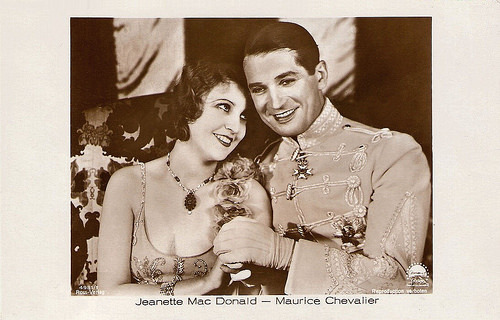
German postcard by Ross Verlag, no. 4981/1, 1929-1930. Photo: Paramount. Publicity still for The Love Parade (Ernst Lubitsch, 1929) with Maurice Chevalier and Jeanette MacDonald.
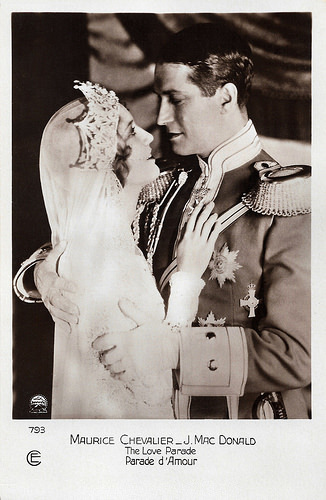
French postcard by Cinémagazine-Edition, Paris, no. 793. Photo: Paramount. Publicity still for The Love Parade (Ernst Lubitsch, 1929).
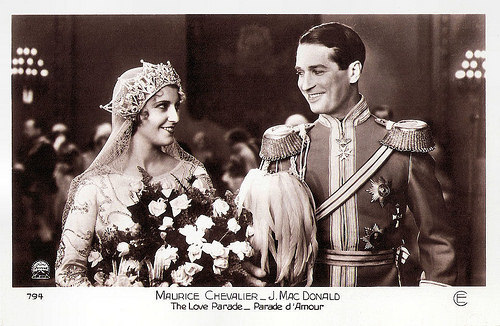
French postcard by Cinémagazine Edition, Paris, no. 794. Photo: Paramount. Publicity still for The Love Parade (Ernst Lubitsch, 1929).
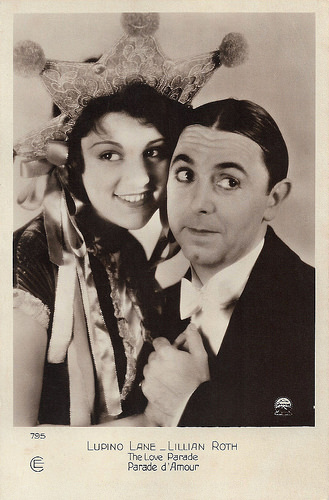
French postcard by Cinémagazine-Edition (CE), Paris, no. 795. Photo: Paramount. Publicity still for The Love Parade (Ernst Lubitsch, 1929) with Lupino Lane and Lillian Roth.
Teasing Gem
The stars in Ernst Lubitsch 's teasing gem The Love Parade (1929) are Maurice Chevalier and Jeanette MacDonald in her film debut. Maurice Chevalier had thought that he would never be capable of acting as a Royal courtier, and had to be persuaded by Lubitsch.
Chevalier plays Count Alfred, military attaché to the Embassy in Paris of mythical Sylvania. He is ordered back to Sylvania to report to Queen Louise (Jeanette MacDonald) for a reprimand following a string of scandals, including an affair with the ambassador's wife.
In the meantime Queen Louise, ruler of Sylvania in her own right, is royally fed-up with her subjects' preoccupation with whom she will marry. Intrigued rather than offended by Count Alfred's dossier, Queen Louise invites him to dinner.
Their romance progresses to the point of marriage. Despite his qualms, Alfred agrees to obey the Queen for love of Louise. However Alfred finds his new life unsatisfying and his position as Queen's Consort without purpose, and the marriage soon runs into difficulties.
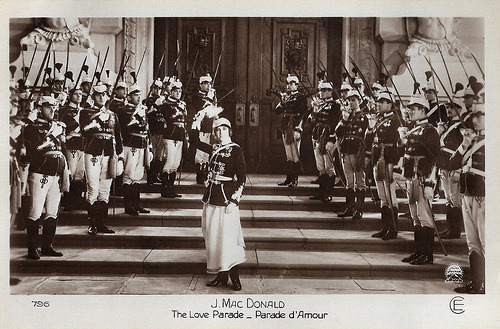
French postcard by Cinémagazine-Edition, no. 796. Photo: Paramount. Publicity still for The Love Parade (Ernst Lubitsch, 1929).
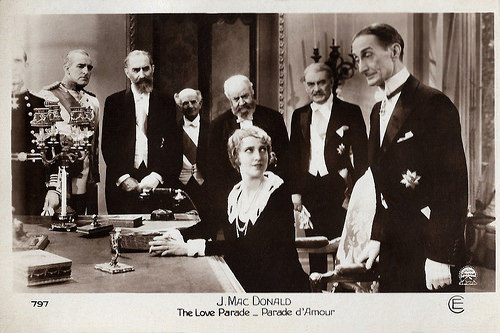
French postcard by Cinémagazine-Edition, no. 797. Photo: Paramount. Publicity still for The Love Parade (Ernst Lubitsch, 1929) with Jeanette MacDonald and Edgar Norton.
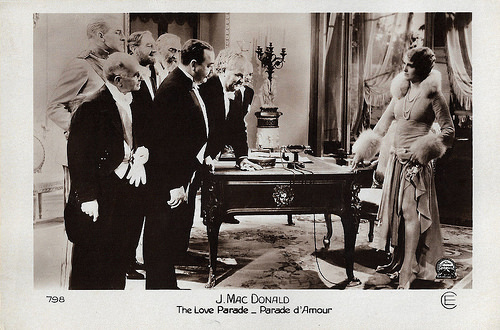
French postcard by Cinémagazine-Edition, no. 798. Photo: Paramount. Publicity still for The Love Parade (Ernst Lubitsch, 1929).
Something unheard of at the time
The Love Parade is notable for being both the film debut of Jeanette MacDonald and the first 'talkie' made by Ernst Lubitsch . Although it was his first sound film, Lubitsch already displayed a mastery of the technical requirements of the day. In one scene, two couples sing the same song alternately.
To do this with the available technology, Lubitsch had two sets built, with an off-camera orchestra between them, and directed both scenes simultaneously. This enabled him to cut back and forth from one scene to the other in editing, something unheard of at the time.
The screenplay by Guy Bolton and Ernest Vajda was adapted from the French play Le Prince Consort, written by Jules Chancel and Leon Xanrof. The play had previously been adapted for Broadway in 1905 by William Boosey and Cosmo Gordon Lennox.
The Love Parade also featured a great supporting cast including British variety star Lupino Lane as Chevalier's orderly Jacques, Lillian Roth as MacDonald's maid Lulu, Eugene Pallette as the Minister of War and Edgar Norton as Master of Ceremonies.
The picture was also released in a French-language version called Parade d'amour. The Love Parade was nominated for six Academy Awards, including Best Picture, Best Actor (Chevalier) and Best Director. This huge box-office hit appeared just after the Wall Street crash, and did much to save the fortunes of Paramount.
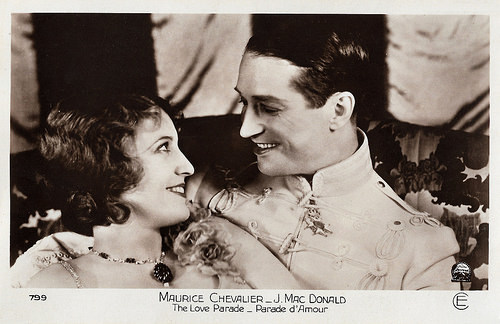
French postcard by Cinémagazine-Edition, no. 799. Photo: Paramount. Publicity still for The Love Parade (Ernst Lubitsch, 1929).
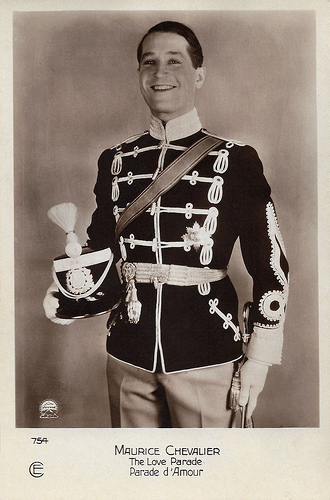
French postcard by Cinémagazine-Edition, no. 754. Photo: Paramount. Publicity still for The Love Parade (Ernst Lubitsch, 1929).
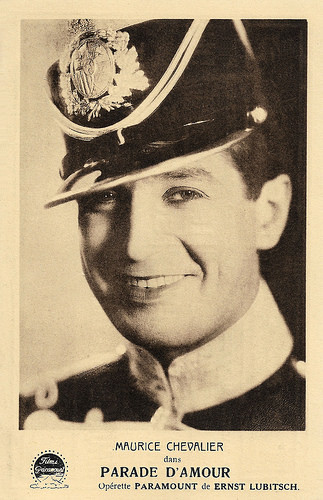
Belgian postcard by Thill, Bruxelles, no. 794. Photo: Paramount. Publicity still for Parade d'amour/The Love Parade (Ernst Lubitsch, 1929).
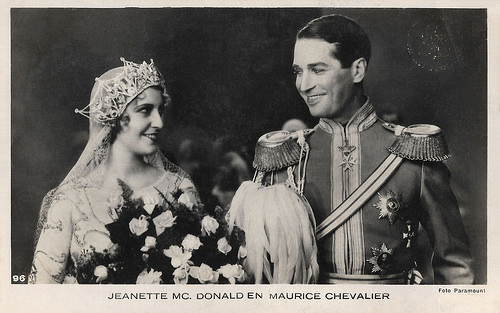
Dutch postcard, no. 96. Photo: Paramount. Publicity still for The Love Parade (Ernst Lubitsch, 1929).
Sources: Wikipedia and IMDb

German postcard by Ross Verlag, no. 4981/1, 1929-1930. Photo: Paramount. Publicity still for The Love Parade (Ernst Lubitsch, 1929) with Maurice Chevalier and Jeanette MacDonald.

French postcard by Cinémagazine-Edition, Paris, no. 793. Photo: Paramount. Publicity still for The Love Parade (Ernst Lubitsch, 1929).

French postcard by Cinémagazine Edition, Paris, no. 794. Photo: Paramount. Publicity still for The Love Parade (Ernst Lubitsch, 1929).

French postcard by Cinémagazine-Edition (CE), Paris, no. 795. Photo: Paramount. Publicity still for The Love Parade (Ernst Lubitsch, 1929) with Lupino Lane and Lillian Roth.
Teasing Gem
The stars in Ernst Lubitsch 's teasing gem The Love Parade (1929) are Maurice Chevalier and Jeanette MacDonald in her film debut. Maurice Chevalier had thought that he would never be capable of acting as a Royal courtier, and had to be persuaded by Lubitsch.
Chevalier plays Count Alfred, military attaché to the Embassy in Paris of mythical Sylvania. He is ordered back to Sylvania to report to Queen Louise (Jeanette MacDonald) for a reprimand following a string of scandals, including an affair with the ambassador's wife.
In the meantime Queen Louise, ruler of Sylvania in her own right, is royally fed-up with her subjects' preoccupation with whom she will marry. Intrigued rather than offended by Count Alfred's dossier, Queen Louise invites him to dinner.
Their romance progresses to the point of marriage. Despite his qualms, Alfred agrees to obey the Queen for love of Louise. However Alfred finds his new life unsatisfying and his position as Queen's Consort without purpose, and the marriage soon runs into difficulties.

French postcard by Cinémagazine-Edition, no. 796. Photo: Paramount. Publicity still for The Love Parade (Ernst Lubitsch, 1929).

French postcard by Cinémagazine-Edition, no. 797. Photo: Paramount. Publicity still for The Love Parade (Ernst Lubitsch, 1929) with Jeanette MacDonald and Edgar Norton.

French postcard by Cinémagazine-Edition, no. 798. Photo: Paramount. Publicity still for The Love Parade (Ernst Lubitsch, 1929).
Something unheard of at the time
The Love Parade is notable for being both the film debut of Jeanette MacDonald and the first 'talkie' made by Ernst Lubitsch . Although it was his first sound film, Lubitsch already displayed a mastery of the technical requirements of the day. In one scene, two couples sing the same song alternately.
To do this with the available technology, Lubitsch had two sets built, with an off-camera orchestra between them, and directed both scenes simultaneously. This enabled him to cut back and forth from one scene to the other in editing, something unheard of at the time.
The screenplay by Guy Bolton and Ernest Vajda was adapted from the French play Le Prince Consort, written by Jules Chancel and Leon Xanrof. The play had previously been adapted for Broadway in 1905 by William Boosey and Cosmo Gordon Lennox.
The Love Parade also featured a great supporting cast including British variety star Lupino Lane as Chevalier's orderly Jacques, Lillian Roth as MacDonald's maid Lulu, Eugene Pallette as the Minister of War and Edgar Norton as Master of Ceremonies.
The picture was also released in a French-language version called Parade d'amour. The Love Parade was nominated for six Academy Awards, including Best Picture, Best Actor (Chevalier) and Best Director. This huge box-office hit appeared just after the Wall Street crash, and did much to save the fortunes of Paramount.

French postcard by Cinémagazine-Edition, no. 799. Photo: Paramount. Publicity still for The Love Parade (Ernst Lubitsch, 1929).

French postcard by Cinémagazine-Edition, no. 754. Photo: Paramount. Publicity still for The Love Parade (Ernst Lubitsch, 1929).

Belgian postcard by Thill, Bruxelles, no. 794. Photo: Paramount. Publicity still for Parade d'amour/The Love Parade (Ernst Lubitsch, 1929).

Dutch postcard, no. 96. Photo: Paramount. Publicity still for The Love Parade (Ernst Lubitsch, 1929).
Sources: Wikipedia and IMDb
Published on June 08, 2018 22:00
June 7, 2018
Rosita (1923)
On a visit to Hollywood, Ernst Lubitsch was contracted by Mary Pickford, who wanted him to direct her in Dorothy Vernon of Haddon Hall. Upon arrival, he rejected the project and directed her instead in Rosita (1923). During the production, the two giants of the silent cinema reportedly clashed.
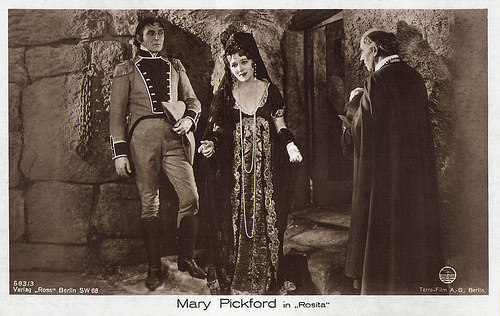
German postcard by Ross Verlag, no. 683/3. Photo: Terra Film A.G., Berlin. Publicity still for Rosita (Ernst Lubitsch, 1923).
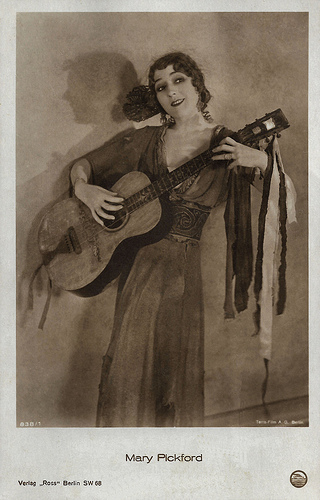
German postcard by Ross Verlag, no. 838/1. Photo: Terra Film A.G., Berlin. Publicity still for Rosita (Ernst Lubitsch, 1923).
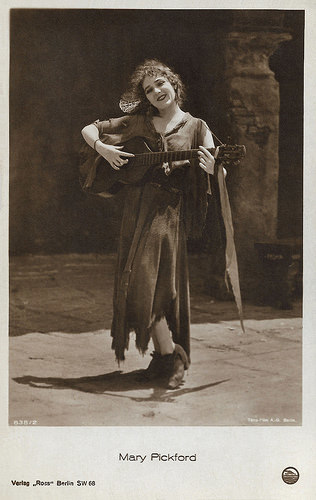
German postcard by Ross Verlag, no. 838/2. Photo: Terra Film A.G., Berlin. Publicity still for Rosita (Ernst Lubitsch, 1923).
A contentious on-set relationship
Mary Pickford and Ernst Lubitsch planned Rosita (1923) as the first of four films they would make togegether for Mary Pickford Films and United Artists. Rosita was meant as Mary Pickford's first adult role. She wanted to abandon her 'little girl with the curls' persona.
Rosita is based upon the 1872 opera Don César de Bazan of Adolphe d'Ennery and Philippe Dumanoir. In a mythical 16th Century Spain the lecherous King (Holbrook Blinn) has cast his eye on a popular but provocative peasant singer (Mary Pickford) who performs in the streets of Seville. She, in turn, yearns for the handsome young nobleman (George Walsh, brother of the celebrated director Raoul Walsh), who has rescued her from the angry king’s guards and has been condemned to a dungeon for his troubles.
Ernst Lubitsch had hesitated about making it, but Pickford eventually convinced him to work on the project. According to IMDb , the role of Don Diego was first offered to Ramon Novarro, on Mary Pickford's urging. He rejected it, however, because Pickford had once stated that his "face and body don't match".
Several postcards with pictures of Pickford and Lubitsch happily working together on the production were produced, despite rumours concerning a contentious on-set relationship between the superstar and her director. By all accounts, he film was a major critical and commercial success on its first release. Rosita earned over $1,000,000. In later years, Pickford turned against the film: in an interview with film historian Kevin Brownlow, Pickford said, "Oh, I detested that picture!... I disliked the director... as much as he disliked me."
Pickford demanded all copies of the film to be ruined. When she handed her films over for preservation she refused to hand over Rosita, except for the fourth reel. Rosita was considered a lost film until a nitrate print was discovered in the Russian archives and repatriated by the Museum of Modern Art in the 1960s. A safety preservation negative was made from the nitrate print, but no further work was done on the film because of the expense and difficulty of recreating the English intertitles.
Happily, a copy of a complete continuity script, which includes all of the intertitles, surfaced in the collection of the Academy of Motion Picture Arts and Sciences. Using the titles in Pickford’s preserved fourth reel as a template, new intertitles were created to match the original. MoMA presented the restored version in 2017 at the 74th Venice International Film Festival.
At AllMovie , Janiss Garza reviews: "For reasons still not clear, Pickford came to hate this film, claiming it was the worst one she ever made. On the contrary, it's excellent entertainment and while the star is not at her very best, she still puts in a decent performance. In its day Rosita was well received critically, and it made money for United Artists. It holds up better today than some of Pickford's other vehicles."
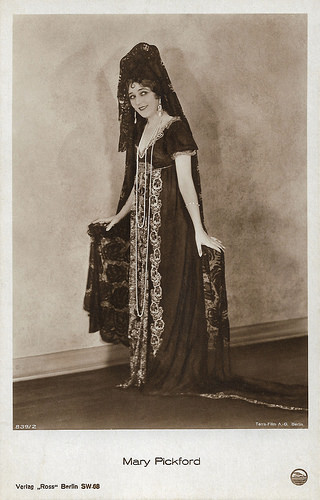
German postcard by Ross Verlag, no. 839/2. Photo: Terra Film A.G., Berlin. Publicity still for Rosita (Ernst Lubitsch, 1923).
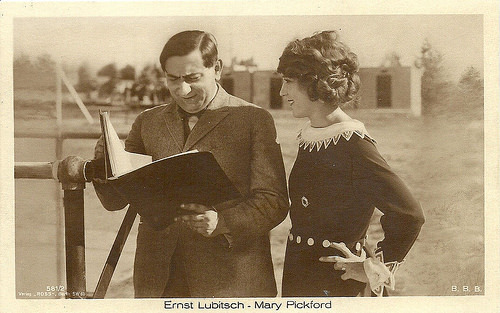
German postcard by Ross Verlag, no. 581/2, 1919-1924. Photo: B.B.B. Collection: Didier Hanson.
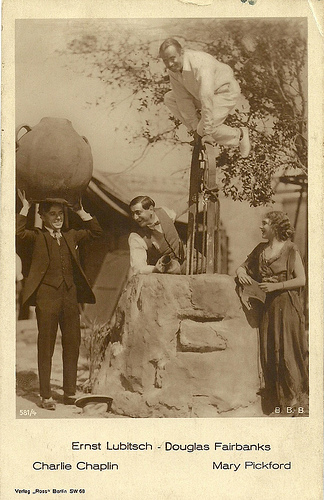
German postcard by Ross Verlag, no. 581/4, 1919-1924. Photo: B.B.B. Collection: Didier Hanson.
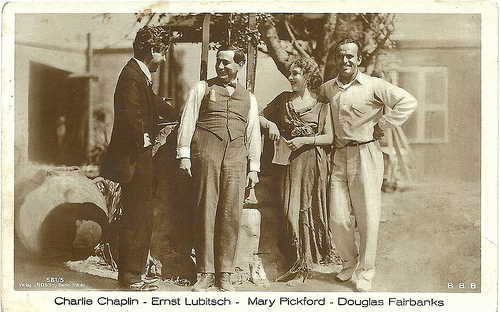
German postcard by Ross Verlag, no. 581/5, 1919-1924. Photo: B.B.B. Collection: Didier Hanson.
Sources: Janiss Garza (AllMovie), The Film Foundation, Wikipedia and IMDb.

German postcard by Ross Verlag, no. 683/3. Photo: Terra Film A.G., Berlin. Publicity still for Rosita (Ernst Lubitsch, 1923).

German postcard by Ross Verlag, no. 838/1. Photo: Terra Film A.G., Berlin. Publicity still for Rosita (Ernst Lubitsch, 1923).

German postcard by Ross Verlag, no. 838/2. Photo: Terra Film A.G., Berlin. Publicity still for Rosita (Ernst Lubitsch, 1923).
A contentious on-set relationship
Mary Pickford and Ernst Lubitsch planned Rosita (1923) as the first of four films they would make togegether for Mary Pickford Films and United Artists. Rosita was meant as Mary Pickford's first adult role. She wanted to abandon her 'little girl with the curls' persona.
Rosita is based upon the 1872 opera Don César de Bazan of Adolphe d'Ennery and Philippe Dumanoir. In a mythical 16th Century Spain the lecherous King (Holbrook Blinn) has cast his eye on a popular but provocative peasant singer (Mary Pickford) who performs in the streets of Seville. She, in turn, yearns for the handsome young nobleman (George Walsh, brother of the celebrated director Raoul Walsh), who has rescued her from the angry king’s guards and has been condemned to a dungeon for his troubles.
Ernst Lubitsch had hesitated about making it, but Pickford eventually convinced him to work on the project. According to IMDb , the role of Don Diego was first offered to Ramon Novarro, on Mary Pickford's urging. He rejected it, however, because Pickford had once stated that his "face and body don't match".
Several postcards with pictures of Pickford and Lubitsch happily working together on the production were produced, despite rumours concerning a contentious on-set relationship between the superstar and her director. By all accounts, he film was a major critical and commercial success on its first release. Rosita earned over $1,000,000. In later years, Pickford turned against the film: in an interview with film historian Kevin Brownlow, Pickford said, "Oh, I detested that picture!... I disliked the director... as much as he disliked me."
Pickford demanded all copies of the film to be ruined. When she handed her films over for preservation she refused to hand over Rosita, except for the fourth reel. Rosita was considered a lost film until a nitrate print was discovered in the Russian archives and repatriated by the Museum of Modern Art in the 1960s. A safety preservation negative was made from the nitrate print, but no further work was done on the film because of the expense and difficulty of recreating the English intertitles.
Happily, a copy of a complete continuity script, which includes all of the intertitles, surfaced in the collection of the Academy of Motion Picture Arts and Sciences. Using the titles in Pickford’s preserved fourth reel as a template, new intertitles were created to match the original. MoMA presented the restored version in 2017 at the 74th Venice International Film Festival.
At AllMovie , Janiss Garza reviews: "For reasons still not clear, Pickford came to hate this film, claiming it was the worst one she ever made. On the contrary, it's excellent entertainment and while the star is not at her very best, she still puts in a decent performance. In its day Rosita was well received critically, and it made money for United Artists. It holds up better today than some of Pickford's other vehicles."

German postcard by Ross Verlag, no. 839/2. Photo: Terra Film A.G., Berlin. Publicity still for Rosita (Ernst Lubitsch, 1923).

German postcard by Ross Verlag, no. 581/2, 1919-1924. Photo: B.B.B. Collection: Didier Hanson.

German postcard by Ross Verlag, no. 581/4, 1919-1924. Photo: B.B.B. Collection: Didier Hanson.

German postcard by Ross Verlag, no. 581/5, 1919-1924. Photo: B.B.B. Collection: Didier Hanson.
Sources: Janiss Garza (AllMovie), The Film Foundation, Wikipedia and IMDb.
Published on June 07, 2018 22:00
June 6, 2018
Sumurun (1920)
Ernst Lubitsch's silent film Sumurun (1920) or One Arabian Night tells the exotic story of the favourite slave girl (Jenny Hasselquist) of a tyrannical sheik (Paul Wegener), who falls in love with a cloth merchant (Harry Liedtke). Meanwhile, a hunchback clown (Lubitsch himself) suffers unrequited love for a travelling dancer (Pola Negri) who wants to join the harem. The film was based on a pantomime by Friedrich Freksa, which Max Reinhardt had already staged and filmed successfully, a decade earlier.

German postcard by Ross Verlag, Berlin. Photo: Union Film. Publicity still for Sumurun (Ernst Lubitsch, 1920) with Pola Negri, Paul Wegener and Jenny Hasselquist .
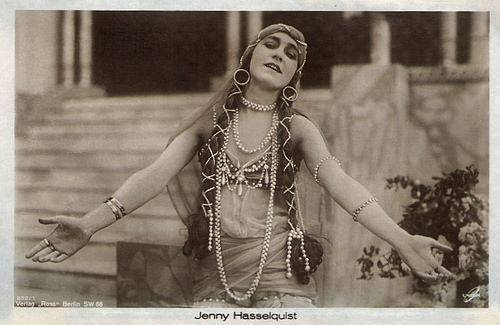
German postcard by Ross Verlag, Berlin, no. 832/1, 1919-1924. Union Film. Publicity still for Sumurun (Ernst Lubitsch, 1920) with Jenny Hasselqvist aka Jenny Hasselquist as Sumurun.
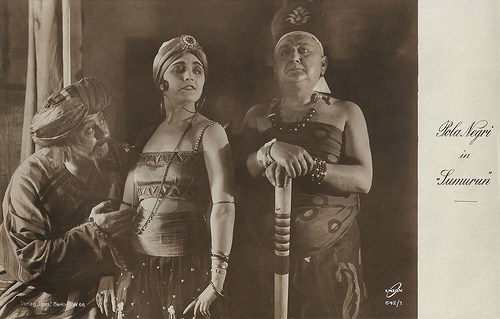
German postcard by Ross Verlag, no. 642/1. Photo: Union-Film. Pola Negri and Jakob Tiedtke in Sumurun (Ernst Lubitsch, 1920).
A Journey into a universe of emotions and passions
A company of travelling performers arrive at a fictional oriental city. It includes the beautiful dancer Janaia ( Pola Negri ), the hunchback clown Yeggar ( Ernst Lubitsch himself in his last leading film role) who is lovesick for Janaia and the Old Lady (Margarete Kupfer) who loves Yeggar.
The Slave Trader Achmed wants to sell Janaia to the Sheik for his harem. At the Palace, the Sheik ( Paul Wegener ) finds out that his favourite, Sumurun ( Jenny Hasselquist ), is in love with Nur al Din (Harry Liedtke), the handsome clothes merchant. He wants to condemn her to death but his son obtains her pardon.
After seeing Janaia dancing, the Sheik is keen to buy her. Yeggar is desperate and takes a magic pill which make him look dead. His body is hidden in a chest. The women from the harem come to Nur al Din's shop and hide him in a chest so that he can be brought into the Palace.
The chest containing Yeggar's body is also brought to the Palace and the Old Lady manages to revive him. The Sheik finds Janaia making love to his son ( Carl Clewing ) and kills both of them. He then finds Sumurun making love to Nur al Din and wants to kill them but he is stabbed in the back by Yeggar.
The filming of Sumurun began at the Ufa studios Union Berlin Tempelhof on 13 March 1920. The monumental sets were realised by Kurt Richter and Erno Metzner. The costumes were designed by Ali Hubert. Sumurun was classified by the Film Censor's Office as not suitable for minors. The première took place on 1 September 1920 in the Ufa-Palast am Zoo in Berlin
The German critics praised Sumurun highly. It was described as "a cinematic journey into a universe of emotions and passions of great intensity and utter perfection, with a remarkable Ernst Lubitsch in one of the main roles."
In the US, The New-York Times wrote that Sumurun gave added evidence that Ernst Lubitsch "is the superior of most directors anywhere, and that Pola Negri,, a Polish-German actress, is one of the few real players of the screen who can make a character live and be something other than an actress playing a part." The New-York Times concluded that, despite some shortcomings, it remained one of the year's best pictures.
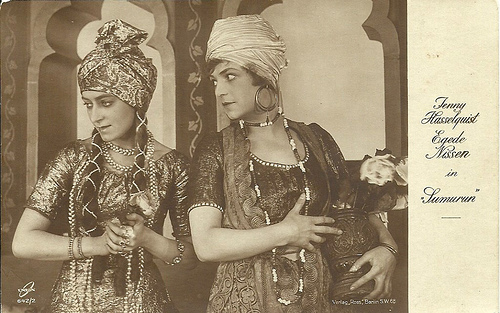
German postcard by Ross Verlag, Berlin, no. 642/2, 1919-1924. Union Film. Publicity still for Sumurun (Ernst Lubitsch, 1920) with Jenny Hasselquist and Aud Egede Nissen . Collection: Didier Hanson.
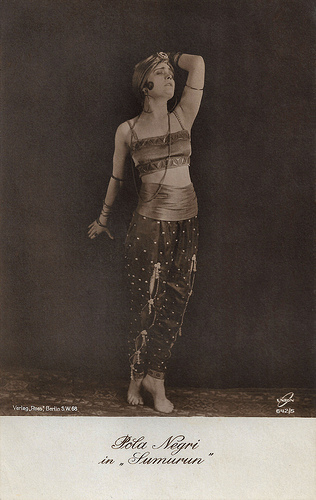
German postcard by Ross Verlag, Berlin, no. 642/5. Photo: Union Film. Pola Negri in Sumurun (Ernst Lubitsch, 1920).
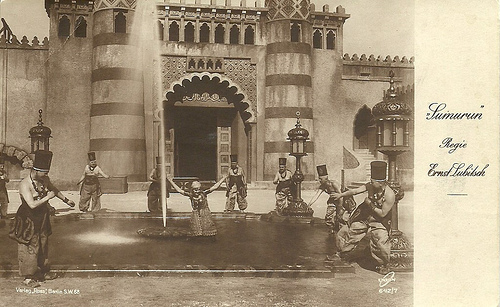
German postcard by Ross Verlag, Berlin, no. 642/7. Photo: Union Film. Publicity still for Sumurun (Ernst Lubitsch, 1920) with Pola Negri . Collection: Didier Hanson.
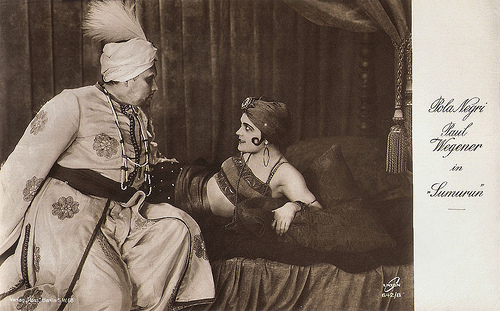 German postcard by Ross Verlag, no. 642/8. Photo: Union-Film. Pola Negri and
Paul Wegener
in Sumurun (Ernst Lubitsch, 1920).
German postcard by Ross Verlag, no. 642/8. Photo: Union-Film. Pola Negri and
Paul Wegener
in Sumurun (Ernst Lubitsch, 1920).
Who is Henrick?
The postcards here below were made for earlier versions of Sumurun. But which one? On the first postcard we could recognise at right Richard Grossman as the old woman. But who is the man left, 'Henrick'?
According to IMDb , Richard Grossman played 'Die alte' (the old woman) in Max Reinhardt's first film, Sumurun (1910), based on a pantomime by Friedrich Freksa. But IMDb does not mention a cast member called 'Henrick' for this silent film, produced by Deutsche Bioscope GmbH (Berlin)
So,perhaps this photo made for Max Reinhardt's stage production of Sumurun (1909)? In Krenn's Berlin-Chronik 1900 bis 1918, several stage members are mentioned in an article on the Berlin premiere (24 April 1910) of the stage production at the Kammerspielen de Deutsches Theaters. The article mentions that the production was a popular success and there had been already 74 performances.
Grete Wiesenthal played the lead as Sumurun and she would repeat her role in the 1910 film version. Leopoldine Konstantin played the dancer, both on stage as in the 1910 film. However, of the four main male actors - Alexander Moissi (as Nur Al Din), Rudolf Schildkraut, Paul Wegener (as the old Sheik) and Eduard von Winterstein (as his son) - only Von Winterstein returned in Reinhardt's film version, but now in the role of the old Sheik.
And Paul Wegener would return as the old Sheik in the 1920 film version of Sumurun by Ernst Lubitsch. But there's no mention of Henrick, so we still don't know for sure for which Sumurun production this postcard was made.
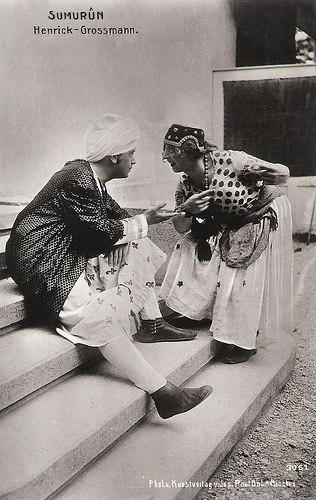
German postcard by Photo und Kunstverlag Jos. Paul Böhm, München, no. 3061. Photo: publicity still for Sumurun (Max Reinhardt, 1910)?
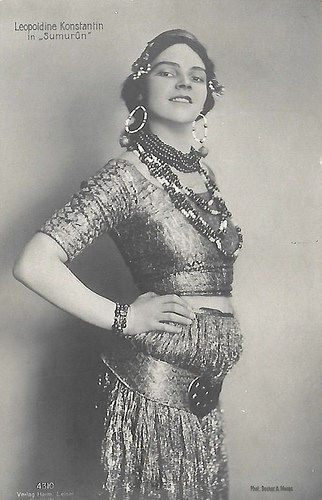
German postcard by Verlag Hermann Leiser, no. 4310. Photo: Becker & Maass. Collection: Didier Hanson.
Leopoldine Konstantin in the 1909 stage production of the exotic dance pantomime Sumurun by Max Reinhardt. Konstantin also made her first film appearance in Max Reinhardt’s early silent film version Sumurun (1910), featuring Bertha Wiesenthal.
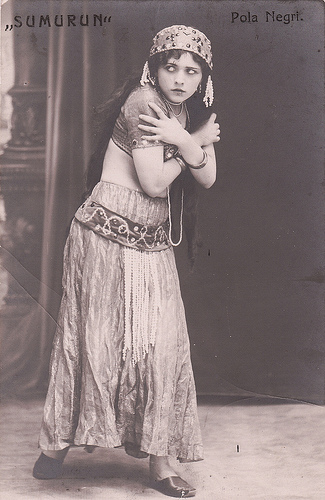
Polish postcard. Photo: publicity still for the play Sumurun. Collection: Marlene Pilaete.
From 1913 on, Pola Negri was a company member of the National Theatre of Warsaw. Her first big break there was her role of the dancer in the Pantomime Sumurun. A year later, she made her first Polish film, and in 1917 she moved to Berlin to make her German film debut. There Ernst Lubitsch made her a star and directed her in his film version of Sumurun (1920). Again she played the role of the dancer.
Sources: Wikipedia and IMDb.

German postcard by Ross Verlag, Berlin. Photo: Union Film. Publicity still for Sumurun (Ernst Lubitsch, 1920) with Pola Negri, Paul Wegener and Jenny Hasselquist .

German postcard by Ross Verlag, Berlin, no. 832/1, 1919-1924. Union Film. Publicity still for Sumurun (Ernst Lubitsch, 1920) with Jenny Hasselqvist aka Jenny Hasselquist as Sumurun.

German postcard by Ross Verlag, no. 642/1. Photo: Union-Film. Pola Negri and Jakob Tiedtke in Sumurun (Ernst Lubitsch, 1920).
A Journey into a universe of emotions and passions
A company of travelling performers arrive at a fictional oriental city. It includes the beautiful dancer Janaia ( Pola Negri ), the hunchback clown Yeggar ( Ernst Lubitsch himself in his last leading film role) who is lovesick for Janaia and the Old Lady (Margarete Kupfer) who loves Yeggar.
The Slave Trader Achmed wants to sell Janaia to the Sheik for his harem. At the Palace, the Sheik ( Paul Wegener ) finds out that his favourite, Sumurun ( Jenny Hasselquist ), is in love with Nur al Din (Harry Liedtke), the handsome clothes merchant. He wants to condemn her to death but his son obtains her pardon.
After seeing Janaia dancing, the Sheik is keen to buy her. Yeggar is desperate and takes a magic pill which make him look dead. His body is hidden in a chest. The women from the harem come to Nur al Din's shop and hide him in a chest so that he can be brought into the Palace.
The chest containing Yeggar's body is also brought to the Palace and the Old Lady manages to revive him. The Sheik finds Janaia making love to his son ( Carl Clewing ) and kills both of them. He then finds Sumurun making love to Nur al Din and wants to kill them but he is stabbed in the back by Yeggar.
The filming of Sumurun began at the Ufa studios Union Berlin Tempelhof on 13 March 1920. The monumental sets were realised by Kurt Richter and Erno Metzner. The costumes were designed by Ali Hubert. Sumurun was classified by the Film Censor's Office as not suitable for minors. The première took place on 1 September 1920 in the Ufa-Palast am Zoo in Berlin
The German critics praised Sumurun highly. It was described as "a cinematic journey into a universe of emotions and passions of great intensity and utter perfection, with a remarkable Ernst Lubitsch in one of the main roles."
In the US, The New-York Times wrote that Sumurun gave added evidence that Ernst Lubitsch "is the superior of most directors anywhere, and that Pola Negri,, a Polish-German actress, is one of the few real players of the screen who can make a character live and be something other than an actress playing a part." The New-York Times concluded that, despite some shortcomings, it remained one of the year's best pictures.

German postcard by Ross Verlag, Berlin, no. 642/2, 1919-1924. Union Film. Publicity still for Sumurun (Ernst Lubitsch, 1920) with Jenny Hasselquist and Aud Egede Nissen . Collection: Didier Hanson.

German postcard by Ross Verlag, Berlin, no. 642/5. Photo: Union Film. Pola Negri in Sumurun (Ernst Lubitsch, 1920).

German postcard by Ross Verlag, Berlin, no. 642/7. Photo: Union Film. Publicity still for Sumurun (Ernst Lubitsch, 1920) with Pola Negri . Collection: Didier Hanson.
 German postcard by Ross Verlag, no. 642/8. Photo: Union-Film. Pola Negri and
Paul Wegener
in Sumurun (Ernst Lubitsch, 1920).
German postcard by Ross Verlag, no. 642/8. Photo: Union-Film. Pola Negri and
Paul Wegener
in Sumurun (Ernst Lubitsch, 1920).Who is Henrick?
The postcards here below were made for earlier versions of Sumurun. But which one? On the first postcard we could recognise at right Richard Grossman as the old woman. But who is the man left, 'Henrick'?
According to IMDb , Richard Grossman played 'Die alte' (the old woman) in Max Reinhardt's first film, Sumurun (1910), based on a pantomime by Friedrich Freksa. But IMDb does not mention a cast member called 'Henrick' for this silent film, produced by Deutsche Bioscope GmbH (Berlin)
So,perhaps this photo made for Max Reinhardt's stage production of Sumurun (1909)? In Krenn's Berlin-Chronik 1900 bis 1918, several stage members are mentioned in an article on the Berlin premiere (24 April 1910) of the stage production at the Kammerspielen de Deutsches Theaters. The article mentions that the production was a popular success and there had been already 74 performances.
Grete Wiesenthal played the lead as Sumurun and she would repeat her role in the 1910 film version. Leopoldine Konstantin played the dancer, both on stage as in the 1910 film. However, of the four main male actors - Alexander Moissi (as Nur Al Din), Rudolf Schildkraut, Paul Wegener (as the old Sheik) and Eduard von Winterstein (as his son) - only Von Winterstein returned in Reinhardt's film version, but now in the role of the old Sheik.
And Paul Wegener would return as the old Sheik in the 1920 film version of Sumurun by Ernst Lubitsch. But there's no mention of Henrick, so we still don't know for sure for which Sumurun production this postcard was made.

German postcard by Photo und Kunstverlag Jos. Paul Böhm, München, no. 3061. Photo: publicity still for Sumurun (Max Reinhardt, 1910)?

German postcard by Verlag Hermann Leiser, no. 4310. Photo: Becker & Maass. Collection: Didier Hanson.
Leopoldine Konstantin in the 1909 stage production of the exotic dance pantomime Sumurun by Max Reinhardt. Konstantin also made her first film appearance in Max Reinhardt’s early silent film version Sumurun (1910), featuring Bertha Wiesenthal.

Polish postcard. Photo: publicity still for the play Sumurun. Collection: Marlene Pilaete.
From 1913 on, Pola Negri was a company member of the National Theatre of Warsaw. Her first big break there was her role of the dancer in the Pantomime Sumurun. A year later, she made her first Polish film, and in 1917 she moved to Berlin to make her German film debut. There Ernst Lubitsch made her a star and directed her in his film version of Sumurun (1920). Again she played the role of the dancer.
Sources: Wikipedia and IMDb.
Published on June 06, 2018 22:00
June 5, 2018
Romeo und Julia im Schnee (1920)
After his smash hit Kohlhiesel's Töchter/Kohlhiesel's Daughters (1920), Ernst Lubitsch made another comical variation on a Shakespeare play, Romeo und Julia im Schnee/Romeo and Juliet in the Snow (1920). This comedy is set in the 19th century in the small village Schwabstedt in the Schwarzwald (Black Forest) where two farmers families are feuding. Romeo is played by unknown Gustav von Wangenheim and Julia by star Lotte Neumann. This was Lubitsch’s last short comedy.
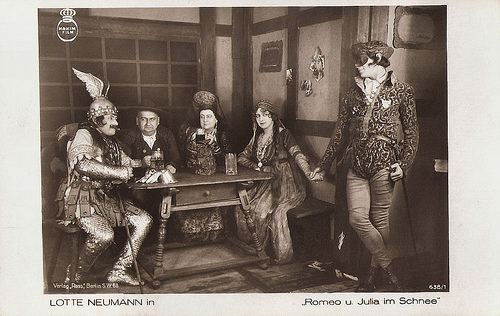
German postcard. Ross Verlag, No. 636/1. Lotte Neumann in the Ernst Lubitsch comedy Romeo und Julia im Schnee (Romeo and Juliet in the Snow, 1920), a Maxim Film production. The man on the left dressed as antique hero could be Julius Falkenstein as Paris. The others are from left to right Jakob Tiedtke (Herr Capulethofer), Marga Köhler (his wife), Lotte Neumann (Julia) and Gustav von Wangenheim (Romeo Montekugerl).

German postcard. Ross Verlag, no. 638/2. Photo: Maxim Film. Publicity still for Romeo und Julia im Schnee/Romeo and Juliet in the Snow (Ernst Lubitsch, 1920), with Lotte Neumann (Julia) and Gustav von Wangenheim (Romeo Montekugerl).
Sugar-water and snowballs
With Romeo und Julia im Schnee/Romeo and Juliet in the Snow (1920), Ernst Lubitsch 'deconstructs' Shakespeare's Romeo and Juliet into an amsusing farce, set in a a wintry Tyrolean village. The script was written by Lubitsch with Hanns Kräly. The two would go on to work together for a long time, and for Kräly, this collaboration would later in his career result in an Oscar.
In Kräly's script, Romeo and Juliet love each other but they can't marry because their families, the Capulethofer and the Montekugerl, are feuding. They are enemies since Mr. Capulethofer (Jakob Tiedtke) and Mr. Montekugerl (Ernst Rückert) wanted to bribe the village judge during a process with a sausage and therefore both were sentenced to pay the process costs.
Julia ( Lotte Neumann ) is supposed to marry the young Paris (Julius Falkenstein), but at first she falls in love with Romeo (Gustav von Wangenheim), the son of the house Montekugerl, who has returned to the village after a year of military service. A mask festival is scheduled, on which Paris wants to court Julia. Romeo, however, manages to make him drunk and to slip into his costume.
Romeo and Juliet decide to marry the same night. Julia, however, should now be betrothed against her will with Paris and Juliet’s father even threatens to cut off Julia’s hair. Faced with their parents opposition to their match, the desperate lovers decide to poison themselves. But unlike in the Shakespeare play, Lubitsch and Kräly serve us a happy ending.
The apothecary gives the loving couple sugar-water instead of poison. They don't die, of course, but Julia has left a farewell letter to her family, and the excitement is great. Convinced their children are dead, the two families admit their faults. The happy lovers leap up and say "Surprise!" And everybody else falls down on an icy patch.
All the characters Romeo und Julia im Schnee/Romeo and Juliet in the Snow are played for comic effect, especially the ridiculous feuding fathers, and many snowballs are hurled in the film. Shooting took place in the Black Forest and also in the Maxim Studios on Blücherstraße in Berlin.
The world premiere of of the film was on 12 March 1920 in the Mozartsaal and in the U.T. Kurfürstendamm in Berlin. This was three days after the release of Lubitsch's other Shakespeare adaptation Kohlhiesel's Töchter/Kohlhiesel's Daughters (1920). That comedy would become the bigger success of the two films, but nowadays reviewers like the Romeo and Julia parody as well.
At IMDb , P. Steier reviews: "A bright comedy. Plenty of low humor. Nice sets and costumes. The best costumes were for scenes at a costume ball."
Another IMDb reviewer, Netwallah adds: "The costume ball is particularly fun to watch, with cousin Tübalder in armor and an absurd winged helmet, and the authorized suitor in a yellow curly wig and angel wings. Better still are the five or six costumes involving enormous papier-maché heads."
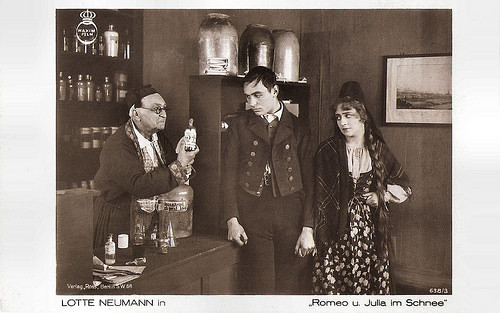
German postcard by Ross Verlag, no. 638/3. Photo: Maxim Film. Publicity still for Romeo und Julia im Schnee/Romeo and Juliet in the Snow (Ernst Lubitsch, 1920), with Lotte Neumann (Julia) and Gustav von Wangenheim (Romeo Montekugerl).
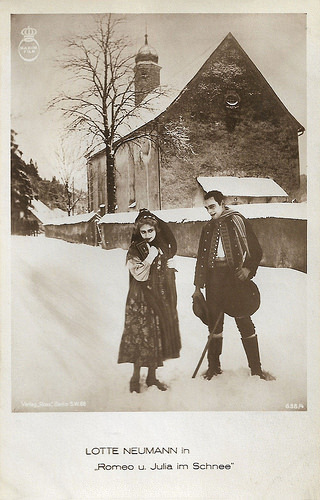
German postcard. Ross Verlag, no. 636/4. Photo: Maxim Film. Publicity still for Romeo und Julia im Schnee/Romeo and Juliet in the Snow (Ernst Lubitsch, 1920), with Lotte Neumann (Julia) and Gustav von Wangenheim (Romeo Montekugerl).
Sources: Thomas Elsaesser (Weimar Cinema and After: Germany's Historical Imaginary), P. Steier (IMDb), Netwallah (IMDb), B.U.F.V.C., Wikipedia (German) and IMDb.

German postcard. Ross Verlag, No. 636/1. Lotte Neumann in the Ernst Lubitsch comedy Romeo und Julia im Schnee (Romeo and Juliet in the Snow, 1920), a Maxim Film production. The man on the left dressed as antique hero could be Julius Falkenstein as Paris. The others are from left to right Jakob Tiedtke (Herr Capulethofer), Marga Köhler (his wife), Lotte Neumann (Julia) and Gustav von Wangenheim (Romeo Montekugerl).

German postcard. Ross Verlag, no. 638/2. Photo: Maxim Film. Publicity still for Romeo und Julia im Schnee/Romeo and Juliet in the Snow (Ernst Lubitsch, 1920), with Lotte Neumann (Julia) and Gustav von Wangenheim (Romeo Montekugerl).
Sugar-water and snowballs
With Romeo und Julia im Schnee/Romeo and Juliet in the Snow (1920), Ernst Lubitsch 'deconstructs' Shakespeare's Romeo and Juliet into an amsusing farce, set in a a wintry Tyrolean village. The script was written by Lubitsch with Hanns Kräly. The two would go on to work together for a long time, and for Kräly, this collaboration would later in his career result in an Oscar.
In Kräly's script, Romeo and Juliet love each other but they can't marry because their families, the Capulethofer and the Montekugerl, are feuding. They are enemies since Mr. Capulethofer (Jakob Tiedtke) and Mr. Montekugerl (Ernst Rückert) wanted to bribe the village judge during a process with a sausage and therefore both were sentenced to pay the process costs.
Julia ( Lotte Neumann ) is supposed to marry the young Paris (Julius Falkenstein), but at first she falls in love with Romeo (Gustav von Wangenheim), the son of the house Montekugerl, who has returned to the village after a year of military service. A mask festival is scheduled, on which Paris wants to court Julia. Romeo, however, manages to make him drunk and to slip into his costume.
Romeo and Juliet decide to marry the same night. Julia, however, should now be betrothed against her will with Paris and Juliet’s father even threatens to cut off Julia’s hair. Faced with their parents opposition to their match, the desperate lovers decide to poison themselves. But unlike in the Shakespeare play, Lubitsch and Kräly serve us a happy ending.
The apothecary gives the loving couple sugar-water instead of poison. They don't die, of course, but Julia has left a farewell letter to her family, and the excitement is great. Convinced their children are dead, the two families admit their faults. The happy lovers leap up and say "Surprise!" And everybody else falls down on an icy patch.
All the characters Romeo und Julia im Schnee/Romeo and Juliet in the Snow are played for comic effect, especially the ridiculous feuding fathers, and many snowballs are hurled in the film. Shooting took place in the Black Forest and also in the Maxim Studios on Blücherstraße in Berlin.
The world premiere of of the film was on 12 March 1920 in the Mozartsaal and in the U.T. Kurfürstendamm in Berlin. This was three days after the release of Lubitsch's other Shakespeare adaptation Kohlhiesel's Töchter/Kohlhiesel's Daughters (1920). That comedy would become the bigger success of the two films, but nowadays reviewers like the Romeo and Julia parody as well.
At IMDb , P. Steier reviews: "A bright comedy. Plenty of low humor. Nice sets and costumes. The best costumes were for scenes at a costume ball."
Another IMDb reviewer, Netwallah adds: "The costume ball is particularly fun to watch, with cousin Tübalder in armor and an absurd winged helmet, and the authorized suitor in a yellow curly wig and angel wings. Better still are the five or six costumes involving enormous papier-maché heads."

German postcard by Ross Verlag, no. 638/3. Photo: Maxim Film. Publicity still for Romeo und Julia im Schnee/Romeo and Juliet in the Snow (Ernst Lubitsch, 1920), with Lotte Neumann (Julia) and Gustav von Wangenheim (Romeo Montekugerl).

German postcard. Ross Verlag, no. 636/4. Photo: Maxim Film. Publicity still for Romeo und Julia im Schnee/Romeo and Juliet in the Snow (Ernst Lubitsch, 1920), with Lotte Neumann (Julia) and Gustav von Wangenheim (Romeo Montekugerl).
Sources: Thomas Elsaesser (Weimar Cinema and After: Germany's Historical Imaginary), P. Steier (IMDb), Netwallah (IMDb), B.U.F.V.C., Wikipedia (German) and IMDb.
Published on June 05, 2018 22:00
June 4, 2018
Kohlhiesels Töchter (1920)
Kohlhiesels Töchter/Kohlhiesel's Daughters (1920) was the most successful film of Ernst Lubitsch's German period. The comedy was extremely popular at the box office, and was re-released more than once.
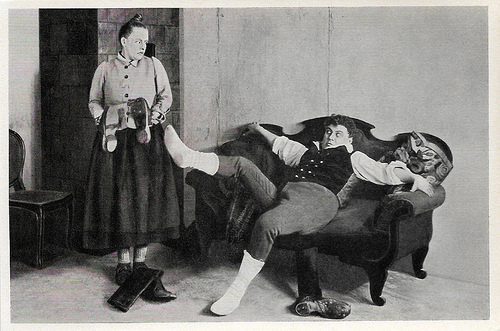
German collectors card by Ross Verlag in the series Vom Werden deutscher Filmkunst - Der Stumme Film, picture no. 119, group 43. Photo: Ufa. Publicity still for Kohlhiesels Töchter/Kohlhiesel's Daughters (Ernst Lubitsch, 1920) with Henny Porten and Emil Jannings .
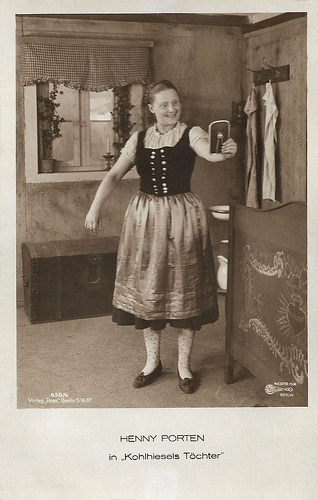
German postcard by Ross Verlag no. 630/4. Photo: Messter Film, Berlin. Publicity still for Kohlhiesels Töchter/Kohlhiesel's Daughters (Ernst Lubitsch, 1920) with Henny Porten .
The Taming of Liesel
Kohlhiesels Töchter/Kohlhiesel's Daughters (Ernst Lubitsch, 1920) takes its basic premise from William Shakespeare's The Taming of the Shrew, relocated to 19th-century southern Bavaria.
The sweet-natured young Gretel wants to get married to Peter Xaver but her father refuses to allow the match until her elder sister Liesel has married first.
As Liesel is notorious for her bad-tempered personality, this is no easy challenge. Xaver's friend Seppel suggests, that Xaver should marry Liesel first, get rid of her and then marry Gretel...
Henny Porten starred in a double role as both Liesel, the older daughter and Gretel, the younger daughter, Emil Jannings played Peter Xaver, Gustav von Wangenheim Paul Seppl, and Jakob Tiedtke was Mathias Kohlhiesel, the father of Liesel and Gretel and keeper of the village inn.
The comedy is an adaptation of the play Kohlhiesel's Daughters by Hanns Kräly, Lubitsch's frequent collaborator, who also worked on the film's screenplay. Three further film adaptations have been made of the work including a 1930 sound remake which also starred Porten.
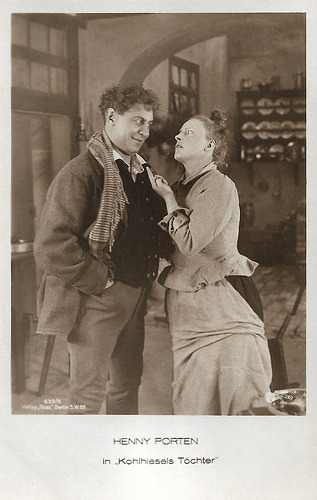
German postcard by Ross Verlag no. 639/5. Photo: Messter-Film. Publicity still for Kohlhiesels Töchter/Kohlhiesel's Daughters (Ernst Lubitsch, 1920) with Emil Jannings and Henny Porten .
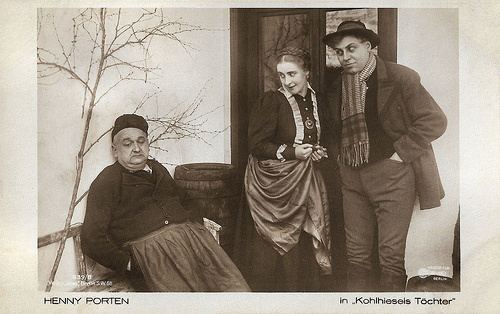
German postcard by Ross Verlag no. 639/8. Photo: Messter-Film. Publicity still for Kohlhiesels Töchter/Kohlhiesel's Daughters (Ernst Lubitsch, 1920) with Jakob Tiedtke, Henny Porten and Emil Jannings .
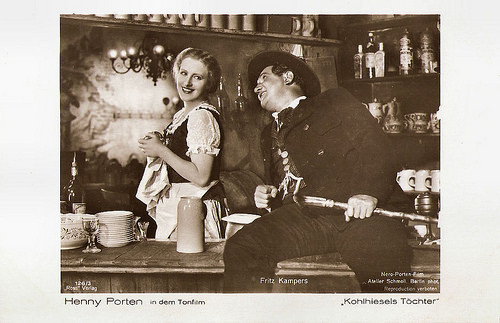
German postcard by Ross Verlag, no. 126/3. Photo: Atelier Schmoll, Berlin / Nero-Porten-Film. Publicity still for Kohlhiesels Töchter/Kohlhiesel's Daughters (Hans Behrendt, 1930) with Henny Porten and Fritz Kampers. The sound version!
Sources: Wikipedia and IMDb.

German collectors card by Ross Verlag in the series Vom Werden deutscher Filmkunst - Der Stumme Film, picture no. 119, group 43. Photo: Ufa. Publicity still for Kohlhiesels Töchter/Kohlhiesel's Daughters (Ernst Lubitsch, 1920) with Henny Porten and Emil Jannings .

German postcard by Ross Verlag no. 630/4. Photo: Messter Film, Berlin. Publicity still for Kohlhiesels Töchter/Kohlhiesel's Daughters (Ernst Lubitsch, 1920) with Henny Porten .
The Taming of Liesel
Kohlhiesels Töchter/Kohlhiesel's Daughters (Ernst Lubitsch, 1920) takes its basic premise from William Shakespeare's The Taming of the Shrew, relocated to 19th-century southern Bavaria.
The sweet-natured young Gretel wants to get married to Peter Xaver but her father refuses to allow the match until her elder sister Liesel has married first.
As Liesel is notorious for her bad-tempered personality, this is no easy challenge. Xaver's friend Seppel suggests, that Xaver should marry Liesel first, get rid of her and then marry Gretel...
Henny Porten starred in a double role as both Liesel, the older daughter and Gretel, the younger daughter, Emil Jannings played Peter Xaver, Gustav von Wangenheim Paul Seppl, and Jakob Tiedtke was Mathias Kohlhiesel, the father of Liesel and Gretel and keeper of the village inn.
The comedy is an adaptation of the play Kohlhiesel's Daughters by Hanns Kräly, Lubitsch's frequent collaborator, who also worked on the film's screenplay. Three further film adaptations have been made of the work including a 1930 sound remake which also starred Porten.

German postcard by Ross Verlag no. 639/5. Photo: Messter-Film. Publicity still for Kohlhiesels Töchter/Kohlhiesel's Daughters (Ernst Lubitsch, 1920) with Emil Jannings and Henny Porten .

German postcard by Ross Verlag no. 639/8. Photo: Messter-Film. Publicity still for Kohlhiesels Töchter/Kohlhiesel's Daughters (Ernst Lubitsch, 1920) with Jakob Tiedtke, Henny Porten and Emil Jannings .

German postcard by Ross Verlag, no. 126/3. Photo: Atelier Schmoll, Berlin / Nero-Porten-Film. Publicity still for Kohlhiesels Töchter/Kohlhiesel's Daughters (Hans Behrendt, 1930) with Henny Porten and Fritz Kampers. The sound version!
Sources: Wikipedia and IMDb.
Published on June 04, 2018 22:00
June 3, 2018
Anna Boleyn (1920)
Anna Boleyn/Anne Boleyn (1920) is one of the silent historical films directed in Germany by the young Ernst Lubitsch. Henny Porten starred as the ill-fated Anne Boleyn and Emil Jannings as King Henry VIII. Ross Verlag published a wonderful series of sepia postcards of the film, often with photos by the Rembrandt studio in Berlin.
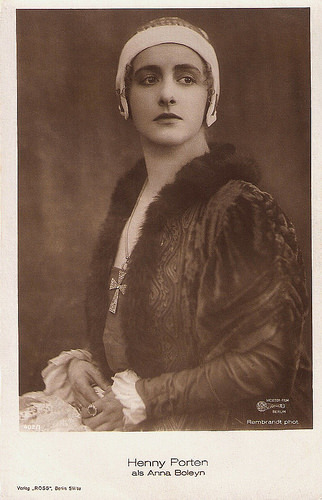
German postcard by Ross Verlag, Berlin, no. 402/1, 1919-1924. Photo: Rembrandt Phot. / Messter Film, Berlin. Publicity still for Anna Boleyn (Ernst Lubitsch, 1920).
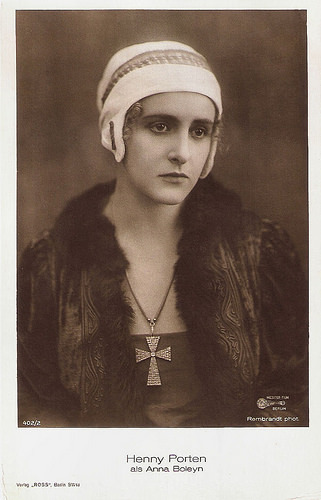
German postcard by Ross Verlag, Berlin, no. 402/2, 1919-1924. Photo: Rembrandt Phot. / Messter Film, Berlin. Publicity still for Anna Boleyn (Ernst Lubitsch, 1920).
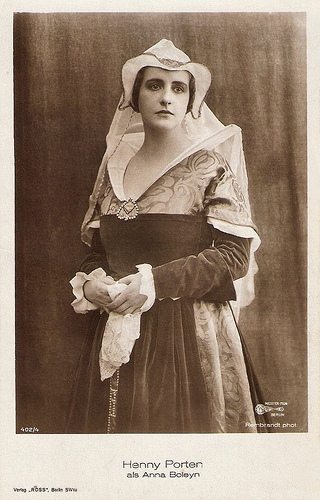
German postcard by Ross Verlag, Berlin, no. 402/4, 1919-1924. Photo: Rembrandt Phot. / Messter Film, Berlin. Publicity still for Anna Boleyn (Ernst Lubitsch, 1920) with Henny Porten .
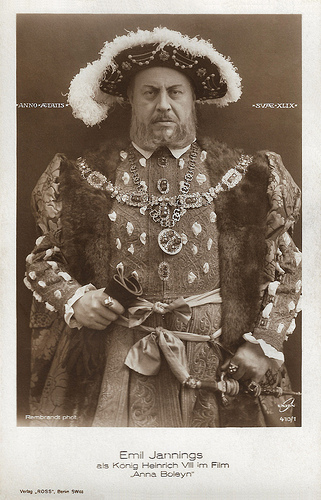
German postcard by Ross Verlag, no. 410/1. Photo: Rembraandt / Union-Film. Emil Jannings as Henry VIII in Anna Boleyn (Ernst Lubitsch, 1920).
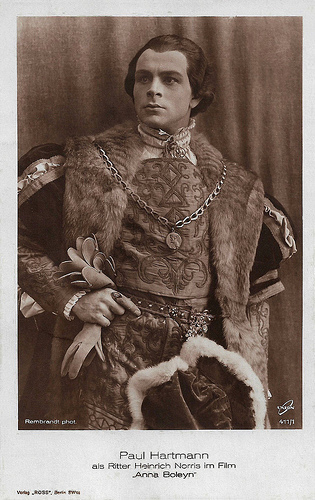
German postcard by Ross Verlag, no. 411/1. Photo: Rembrandt / Union. Paul Hartmann as Sir Henry Norris in Anna Boleyn (Ernst Lubitsch, 1920).
The Bad Tempered King of England
Anne Boleyn was the second wife of King Henry VIII of England. Their marriage led to momentous political and religious turmoil. For Ernst Lubitsch ' film the script was written by Norbert Falk (as Fred Orbing) and Hanns Kräly.
Lubitsch presents Anna ( Henny Porten ) as an innocent, a naïve and guileless young woman who is the newly arrived lady-in-waiting to the Queen. She catches the lustful eye of Henry VIII ( Emil Jannings ), who loves to feast, drink, hunt, and chase around after young beauties. He is tired of Queen to Catherine of Aragon (Hedwig Pauly-Winterstein), and annuls his marriage to her, against the wishes of the pope.
The pompous monarch breaks with Rome, forms the Church of England and marries Anne at the Cathedral. The marriage and the sumptuous festivities that follow are filmed by Lubitsch as spectacular crowd scenes.
Henry tells Anne it is her holy duty to produce a male heir to the throne. But when Anne only gives birth to a baby girl (the later Queen Elizabeth), Henry VIII soon has his eye on yet another lady-in-waiting, Jane Seymour ( Aud Egede Nissen ).
The bad-tempered King charges his wife with adultery and treason, and imprisons her in the Tower of London. Anne is tortured and confesses to infidelity. She is sentenced to death and in the final scene of the film she is beheaded.
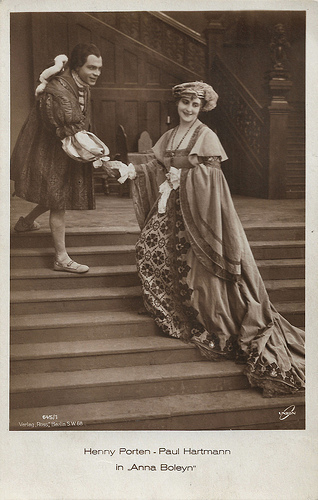
German postcard by Ross Verlag, Berlin, no. 645/1. Photo: Union. Publicity still for Anna Boleyn (Ernst Lubitsch, 1920) with Henny Porten and Paul Hartmann .
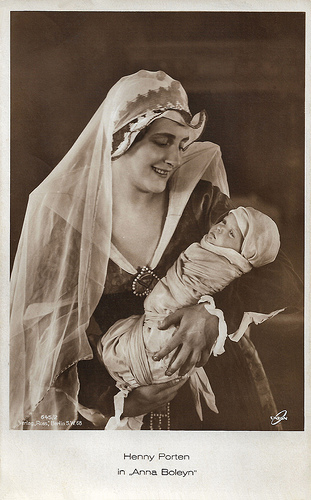
German postcard by Ross Verlag, Berlin, no. 645/2. Photo: Union. Publicity still for Anna Boleyn (Ernst Lubitsch, 1920) with Henny Porten .
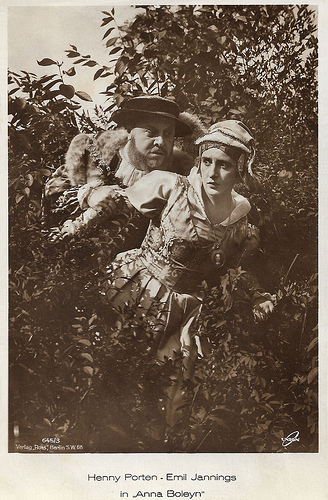
German postcard by Ross Verlag, Berlin, no. 645/3. Photo: Union Film. Publicity still for Anna Boleyn (Ernst Lubitsch, 1920) with Emil Jannings and Henny Porten.
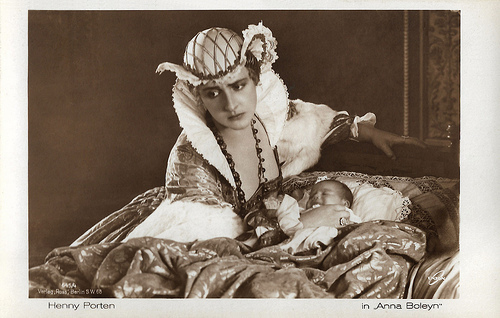
German postcard by Ross Verlag, Berlin, no. 645/4. Photo: Union Film. The baby represents the future queen Elizabeth I.
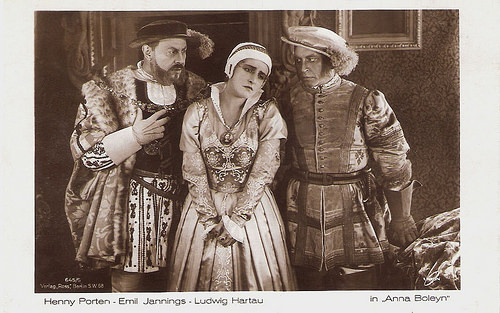
German postcard by Ross Verlag, Berlin, no. 645/5. Photo: Union. Publicity still for Anna Boleyn (Ernst Lubitsch, 1920) with Emil Jannings , Henny Porten and Ludwig Hartau as the Duke of Norfolk.
The time is worth spending
In Anna Boleyn/Anne Boleyn (1920), Ernst Lubitsch lets his characters breathe and reveal their corruption down to the tiniest of meannesses. He takes his time, which can try the patience of an audience accustomed to being carried away by action, but the time is worth spending.
A beautiful aspect of Anna Boleyn are the very lavish medieval costuming and the large and elaborate exterior and interior sets. The outdoor scenes are impressive for 1920: a court sports event, Anna’s coronation, a Spring Festival, a hunt, a joust, and even a street battle outside the cathedral.
Emil Jannings is striking and memorable as King Henry the Eighth. He seems to have stepped straight out of Hans Holbein's famous portrait of King Henry VIII.
To introduce the king, Lubitsch uses one of his favourite comedy techniques: the pull-back-and-reveal. A year earlier, he had used this technique in the opening shot of Die Austernprinzessin/The Oyster Princess (1919) to show the bloated Oyster King surrounded by his lackeys. That shot is duplicated here and the look is slightly more realistic but just as revelatory of the character.
Anna Boleyn’s innocence is underlined by Lubitsch through the contrast with the very different character of Jane Seymour ( Aud Egede Nissen ). Jane is in a sense a mirror image in negative of Anna ( Henny Porten ). In the late confrontation between the two, Jane claims that she serves Anna, but Lubitsch once again positions Anna as innocent: here, dressed in a simple nightdress, Anna kneels before the haughty Jane in her fine clothes.
Ernst Lubitsch constantly composes shots in depth in Anna Boleyn, looking down corridors or through into larger rooms, from the early moments at the harbour where a set of doors are opened onto a bustling street, to the haunting final view of the scaffold.
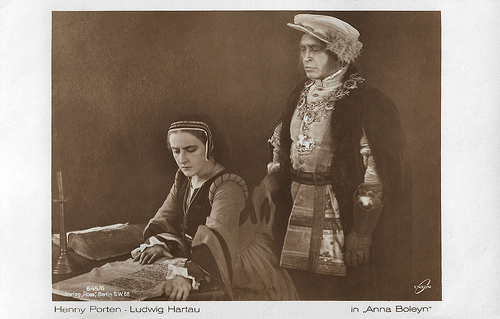
German postcard by Ross Verlag, Berlin, no. 645/6. Photo: Union. Publicity still for Anna Boleyn (Ernst Lubitsch, 1920) with Henny Porten and Ludwig Hartau.
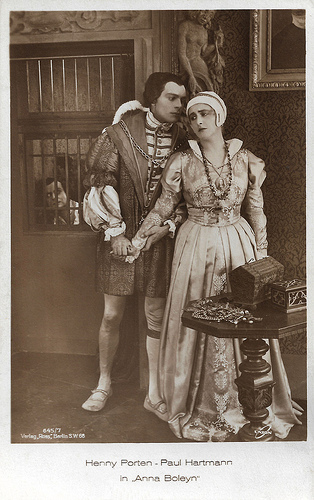
German postcard by Ross Verlag, Berlin, no. 645/7. Photo: Union. Publicity still for Anna Boleyn (Ernst Lubitsch, 1920) with Henny Porten (Anna Boleyn) and Paul Hartmann (Sir Henry Norris). Anna is loyal to her King, so she rejects Henry's love. The diabolic court poet Marc Smeton (Ferdinand von Alten) spies upon them and will betray them to the King.
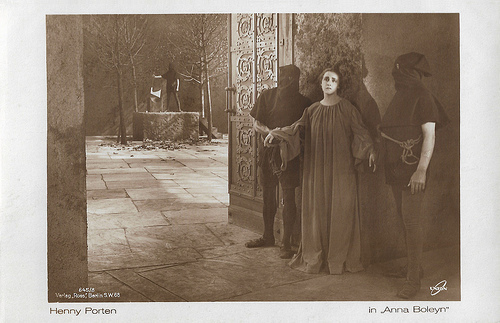
German postcard by Ross Verlag, no. 645/8. Photo: Union. Publicity still for Anna Boleyn (Ernst Lubitsch, 1920) with Henny Porten .
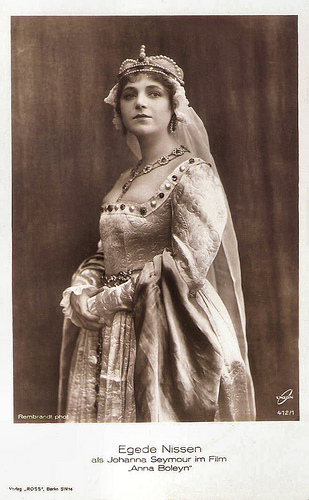
German postcard by Ross Verlag, Berlin, no. 472/1. Photo: Rembrandt Phot. / Union Film with Aud Egede Nissen
For the film Anna Boleyn a tournament set is built at the Tempelhof studio. German collectors card by Ross Verlag in the series Vom Werden Deutscher Filmkunst - Der Stumme Film, no. 149, group 43. Photo: Union-Messter-Film.
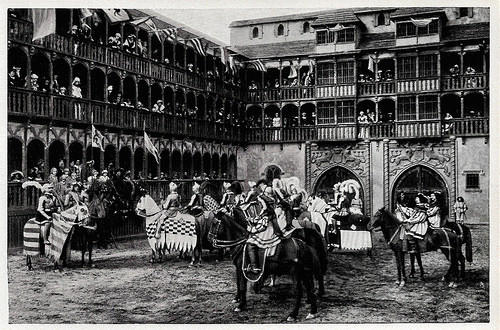
And as it later appeared in the film. German collectors card by Ross Verlag in the series Vom Werden Deutscher Filmkunst - Der Stumme Film, picture no. 150, group 43. Photo: Ufa. Set for Anna Boleyn (Ernst Lubitsch, 1920).
Bland characterisation
Most critics on the net have mixed thoughts about the film. Ian Johnston at Not Coming to a Theater Near You : "Anna Boleyn does everything to meet the requirements of the historical epic. (...) But the film suffers from Anna’s bland characterisation and a general plodding, predictable tone. It only really comes alive with the character of King Henry."
Lubitsch' film was not the only art work inspired by the tragic figure of Anna Boleyn. Anna has inspired or been mentioned in numerous paintings, novels and films.
In the cinema, she was first portrayed by Clara Kimball Young in a 1912 short film about Cardinal Wolsey. After the portrayal by Henny Porten followed Merle Oberon in the sound film The Private Life of Henry VIII which won an Oscar for Charles Laughton 's portrayal of Henry. Oberon received an Oscar nomination.
Elaine Stewart played Anne Boleyn in the film Young Bess (1953), starring Jean Simmons . Geneviève Bujold won a Golden Globe Award, and was nominated for an Oscar, for her portrayal of Anne in Anne of the Thousand Days (1969).
Dorothy Tutin was nominated for a BAFTA TV Award for her role as Anne in the mini-series The Six Wives of Henry VIII (1970). When that mini-series was compressed into a film, Charlotte Rampling played Anne in the film version entitled Henry VIII and his Six Wives (1972). And, Natalie Portman portrayed Anne excellently in the film The Other Boleyn Girl (2008).
Finally, reviewer Helotropetwo at IMDb, loves Lubitsch's Anna Boleyn: "Nothing dull about this movie, which is held together by fully realized characters with some depth to them. Even the hooded torturers have body language. Jannings' performance is brilliant, all will, want and need. A Henry VIII as he must have been. Henny Porten is, maybe, nobler and purer than Anne Boleyn, but she plays the part as written: A victim caught in the jaws of a big (huge) baby."
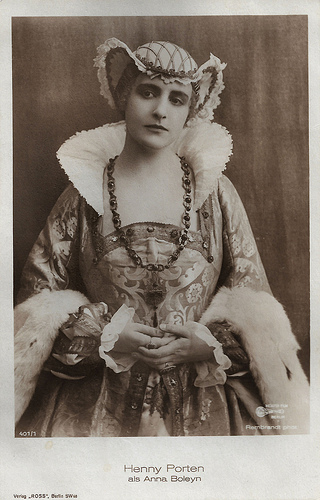
German postcard by Ross Verlag, Berlin, no. 401/1. Photo: Rembrandt / Messter Film. Henny Porten in Anna Boleyn (Ernst Lubitsch, 1920).
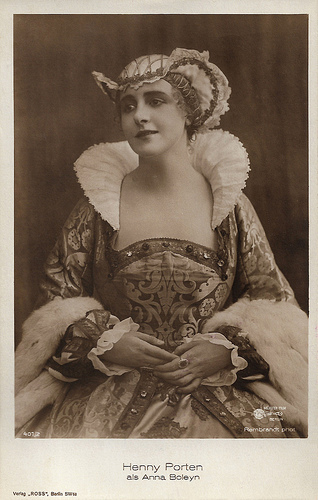
German postcard by Ross Verlag, Berlin, no. 401/2. Photo: Rembrandt Phot. / Messter Film, Berlin. Publicity still for Anna Boleyn (Ernst Lubitsch, 1920).
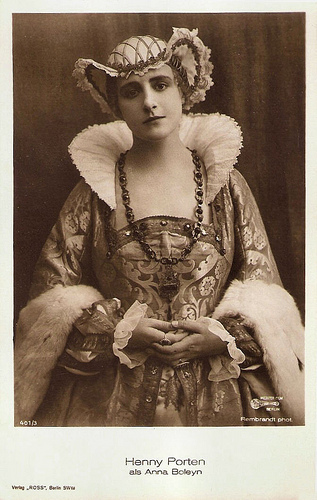
German postcard by Ross Verlag, Berlin, no. 401/3. Photo: Rembrandt Phot. / Messter Film, Berlin. Publicity still for Anna Boleyn (Ernst Lubitsch, 1920).
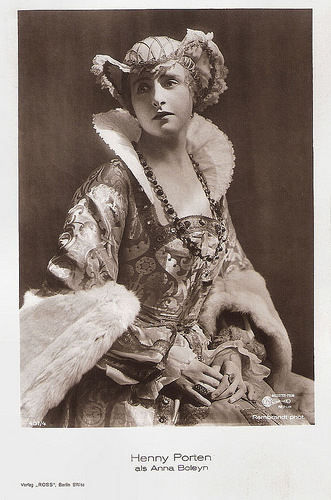
German postcard by Ross Verlag, Berlin, no. 401/4. Photo: Rembrandt Phot. / Messter Film, Berlin. Publicity still for Anna Boleyn (Ernst Lubitsch, 1920).
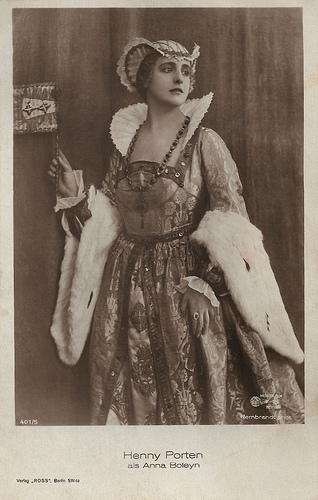
German postcard by Ross Verlag, Berlin, no. 401/5. Photo: Rembrandt Phot. / Messter Film, Berlin. Publicity still for Anna Boleyn (Ernst Lubitsch, 1920).
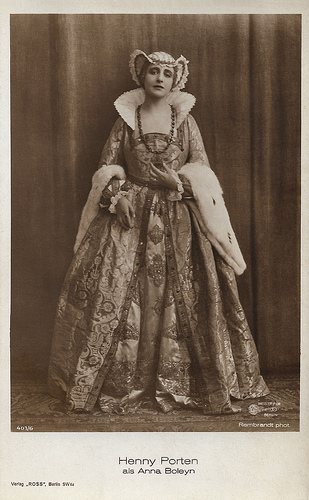
German postcard by Ross Verlag, Berlin, no. 401/6. Photo: Rembrandt Phot. / Messter Film, Berlin. Henny Porten in Anna Boleyn (Ernst Lubitsch, 1920).
Sources: Jason Ankeny (AllMovie), Fernando F. Croce (Slant), Ian Johnston (Not Coming to a Theater Near You), AllMovie, Wikipedia and IMDb.

German postcard by Ross Verlag, Berlin, no. 402/1, 1919-1924. Photo: Rembrandt Phot. / Messter Film, Berlin. Publicity still for Anna Boleyn (Ernst Lubitsch, 1920).

German postcard by Ross Verlag, Berlin, no. 402/2, 1919-1924. Photo: Rembrandt Phot. / Messter Film, Berlin. Publicity still for Anna Boleyn (Ernst Lubitsch, 1920).

German postcard by Ross Verlag, Berlin, no. 402/4, 1919-1924. Photo: Rembrandt Phot. / Messter Film, Berlin. Publicity still for Anna Boleyn (Ernst Lubitsch, 1920) with Henny Porten .

German postcard by Ross Verlag, no. 410/1. Photo: Rembraandt / Union-Film. Emil Jannings as Henry VIII in Anna Boleyn (Ernst Lubitsch, 1920).

German postcard by Ross Verlag, no. 411/1. Photo: Rembrandt / Union. Paul Hartmann as Sir Henry Norris in Anna Boleyn (Ernst Lubitsch, 1920).
The Bad Tempered King of England
Anne Boleyn was the second wife of King Henry VIII of England. Their marriage led to momentous political and religious turmoil. For Ernst Lubitsch ' film the script was written by Norbert Falk (as Fred Orbing) and Hanns Kräly.
Lubitsch presents Anna ( Henny Porten ) as an innocent, a naïve and guileless young woman who is the newly arrived lady-in-waiting to the Queen. She catches the lustful eye of Henry VIII ( Emil Jannings ), who loves to feast, drink, hunt, and chase around after young beauties. He is tired of Queen to Catherine of Aragon (Hedwig Pauly-Winterstein), and annuls his marriage to her, against the wishes of the pope.
The pompous monarch breaks with Rome, forms the Church of England and marries Anne at the Cathedral. The marriage and the sumptuous festivities that follow are filmed by Lubitsch as spectacular crowd scenes.
Henry tells Anne it is her holy duty to produce a male heir to the throne. But when Anne only gives birth to a baby girl (the later Queen Elizabeth), Henry VIII soon has his eye on yet another lady-in-waiting, Jane Seymour ( Aud Egede Nissen ).
The bad-tempered King charges his wife with adultery and treason, and imprisons her in the Tower of London. Anne is tortured and confesses to infidelity. She is sentenced to death and in the final scene of the film she is beheaded.

German postcard by Ross Verlag, Berlin, no. 645/1. Photo: Union. Publicity still for Anna Boleyn (Ernst Lubitsch, 1920) with Henny Porten and Paul Hartmann .

German postcard by Ross Verlag, Berlin, no. 645/2. Photo: Union. Publicity still for Anna Boleyn (Ernst Lubitsch, 1920) with Henny Porten .

German postcard by Ross Verlag, Berlin, no. 645/3. Photo: Union Film. Publicity still for Anna Boleyn (Ernst Lubitsch, 1920) with Emil Jannings and Henny Porten.

German postcard by Ross Verlag, Berlin, no. 645/4. Photo: Union Film. The baby represents the future queen Elizabeth I.

German postcard by Ross Verlag, Berlin, no. 645/5. Photo: Union. Publicity still for Anna Boleyn (Ernst Lubitsch, 1920) with Emil Jannings , Henny Porten and Ludwig Hartau as the Duke of Norfolk.
The time is worth spending
In Anna Boleyn/Anne Boleyn (1920), Ernst Lubitsch lets his characters breathe and reveal their corruption down to the tiniest of meannesses. He takes his time, which can try the patience of an audience accustomed to being carried away by action, but the time is worth spending.
A beautiful aspect of Anna Boleyn are the very lavish medieval costuming and the large and elaborate exterior and interior sets. The outdoor scenes are impressive for 1920: a court sports event, Anna’s coronation, a Spring Festival, a hunt, a joust, and even a street battle outside the cathedral.
Emil Jannings is striking and memorable as King Henry the Eighth. He seems to have stepped straight out of Hans Holbein's famous portrait of King Henry VIII.
To introduce the king, Lubitsch uses one of his favourite comedy techniques: the pull-back-and-reveal. A year earlier, he had used this technique in the opening shot of Die Austernprinzessin/The Oyster Princess (1919) to show the bloated Oyster King surrounded by his lackeys. That shot is duplicated here and the look is slightly more realistic but just as revelatory of the character.
Anna Boleyn’s innocence is underlined by Lubitsch through the contrast with the very different character of Jane Seymour ( Aud Egede Nissen ). Jane is in a sense a mirror image in negative of Anna ( Henny Porten ). In the late confrontation between the two, Jane claims that she serves Anna, but Lubitsch once again positions Anna as innocent: here, dressed in a simple nightdress, Anna kneels before the haughty Jane in her fine clothes.
Ernst Lubitsch constantly composes shots in depth in Anna Boleyn, looking down corridors or through into larger rooms, from the early moments at the harbour where a set of doors are opened onto a bustling street, to the haunting final view of the scaffold.

German postcard by Ross Verlag, Berlin, no. 645/6. Photo: Union. Publicity still for Anna Boleyn (Ernst Lubitsch, 1920) with Henny Porten and Ludwig Hartau.

German postcard by Ross Verlag, Berlin, no. 645/7. Photo: Union. Publicity still for Anna Boleyn (Ernst Lubitsch, 1920) with Henny Porten (Anna Boleyn) and Paul Hartmann (Sir Henry Norris). Anna is loyal to her King, so she rejects Henry's love. The diabolic court poet Marc Smeton (Ferdinand von Alten) spies upon them and will betray them to the King.

German postcard by Ross Verlag, no. 645/8. Photo: Union. Publicity still for Anna Boleyn (Ernst Lubitsch, 1920) with Henny Porten .

German postcard by Ross Verlag, Berlin, no. 472/1. Photo: Rembrandt Phot. / Union Film with Aud Egede Nissen
For the film Anna Boleyn a tournament set is built at the Tempelhof studio. German collectors card by Ross Verlag in the series Vom Werden Deutscher Filmkunst - Der Stumme Film, no. 149, group 43. Photo: Union-Messter-Film.

And as it later appeared in the film. German collectors card by Ross Verlag in the series Vom Werden Deutscher Filmkunst - Der Stumme Film, picture no. 150, group 43. Photo: Ufa. Set for Anna Boleyn (Ernst Lubitsch, 1920).
Bland characterisation
Most critics on the net have mixed thoughts about the film. Ian Johnston at Not Coming to a Theater Near You : "Anna Boleyn does everything to meet the requirements of the historical epic. (...) But the film suffers from Anna’s bland characterisation and a general plodding, predictable tone. It only really comes alive with the character of King Henry."
Lubitsch' film was not the only art work inspired by the tragic figure of Anna Boleyn. Anna has inspired or been mentioned in numerous paintings, novels and films.
In the cinema, she was first portrayed by Clara Kimball Young in a 1912 short film about Cardinal Wolsey. After the portrayal by Henny Porten followed Merle Oberon in the sound film The Private Life of Henry VIII which won an Oscar for Charles Laughton 's portrayal of Henry. Oberon received an Oscar nomination.
Elaine Stewart played Anne Boleyn in the film Young Bess (1953), starring Jean Simmons . Geneviève Bujold won a Golden Globe Award, and was nominated for an Oscar, for her portrayal of Anne in Anne of the Thousand Days (1969).
Dorothy Tutin was nominated for a BAFTA TV Award for her role as Anne in the mini-series The Six Wives of Henry VIII (1970). When that mini-series was compressed into a film, Charlotte Rampling played Anne in the film version entitled Henry VIII and his Six Wives (1972). And, Natalie Portman portrayed Anne excellently in the film The Other Boleyn Girl (2008).
Finally, reviewer Helotropetwo at IMDb, loves Lubitsch's Anna Boleyn: "Nothing dull about this movie, which is held together by fully realized characters with some depth to them. Even the hooded torturers have body language. Jannings' performance is brilliant, all will, want and need. A Henry VIII as he must have been. Henny Porten is, maybe, nobler and purer than Anne Boleyn, but she plays the part as written: A victim caught in the jaws of a big (huge) baby."

German postcard by Ross Verlag, Berlin, no. 401/1. Photo: Rembrandt / Messter Film. Henny Porten in Anna Boleyn (Ernst Lubitsch, 1920).

German postcard by Ross Verlag, Berlin, no. 401/2. Photo: Rembrandt Phot. / Messter Film, Berlin. Publicity still for Anna Boleyn (Ernst Lubitsch, 1920).

German postcard by Ross Verlag, Berlin, no. 401/3. Photo: Rembrandt Phot. / Messter Film, Berlin. Publicity still for Anna Boleyn (Ernst Lubitsch, 1920).

German postcard by Ross Verlag, Berlin, no. 401/4. Photo: Rembrandt Phot. / Messter Film, Berlin. Publicity still for Anna Boleyn (Ernst Lubitsch, 1920).

German postcard by Ross Verlag, Berlin, no. 401/5. Photo: Rembrandt Phot. / Messter Film, Berlin. Publicity still for Anna Boleyn (Ernst Lubitsch, 1920).

German postcard by Ross Verlag, Berlin, no. 401/6. Photo: Rembrandt Phot. / Messter Film, Berlin. Henny Porten in Anna Boleyn (Ernst Lubitsch, 1920).
Sources: Jason Ankeny (AllMovie), Fernando F. Croce (Slant), Ian Johnston (Not Coming to a Theater Near You), AllMovie, Wikipedia and IMDb.
Published on June 03, 2018 22:00
June 2, 2018
Rausch (1919)
Ernst Lubitsch directed legendary film diva Asta Nielsen in the silent drama Rausch/Intoxication (1919). The film was based on the play Brott och brott (Love and Bread) by August Strindberg, and Alfred Abel and Carl Meinhardt were Nielsen's leading men. Lubitsch was loaned out from Union-Film to the smaller Argus-Film for the production. Sadly, the film is now considered as lost.
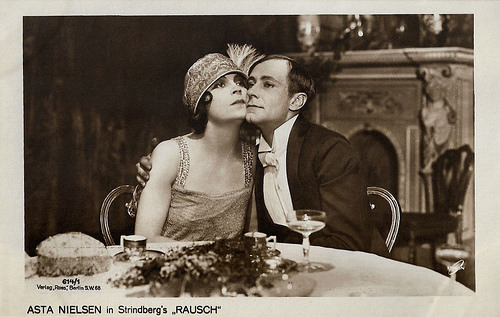
German postcard by Ross Verlag, no. 614/1. Photo: Union. Publicity still for Rausch/Intoxication (Ernst Lubitsch, 1919) with Asta Nielsen and Alfred Abel .
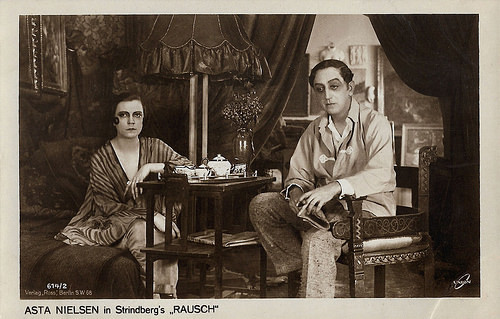
German postcard by Ross Verlag, no. 614/2. Photo: Union. Publicity still for Rausch/Intoxication (Ernst Lubitsch, 1919) with Asta Nielsen and Carl Meinhardt.
Suspected of manslaughter
During the First World War, Asta Nielsen met Frida Strindberg, playwright August Strindberg's former wife, in New York City during an American trip. Strindberg wanted to have Rausch filmed by the Fox studio. Asta Nielsen , who was stuck in New York due to the sea blockade, agreed to take over the lead role for financial reasons. However, the project was abandoned before filming had begun, according to German Wikipedia because of the working conditions at Fox.
After the war, theatre director Carl (or Karl) Meinhard resumed the idea of the Strindberg film adaptation, especially since Rausch had a successful run at German theatres. He persuaded Nielsen, who was then living in Copenhagen, to take on the lead role, while he himself took a supporting role in the film. It was Nielsen's first film after the war and also the only one that brought her together with Ernst Lubitsch .
Alfred Abel played the author Gaston, who finally succeeds as a dramatist in Paris at the turn of the 20th Century. He falls in love with Henriette ( Asta Nielsen ), the wife of his friend Adolph (Carl Meinhard). In the rush of his of feelings, he leaves his wife Jeanne (Grete Diercks) and their little daughter Marion.
Marion dies by an unfortunate accident and Gaston and Jeanne are suspected of manslaughter. Both accuse each other - Gaston in turn becomes a social outsider and is both professionally and privately increasingly unsuccessful. In the end, it turns out that Marion has died a natural death. Gaston and Jeanne are finally going their separate ways.
During the filming in the Berlin Filmatelier Chausseestraße, it came again and again to differences of opinion between Ernst Lubitsch , scriptwriter Hanns Kräly and Asta Nielsen . Nevertheless, Nielsen described in her 1946 autobiography Die schweigende Muse (The Silent Muse) the shooting as "a happy collaboration with Lubitsch", among other things, because he understood actors and possessed even at that time "excellent ... skills as a director".
Cinematographer of Rausch was Karl Freund. The sets were designed by Rochus Gliese and probably also by Paul Leni. The latter was not officially credited as a set designer but the National Film Archive in London has in its collection designs by Leni for the film. Rausch premiered on 1 August 1919 in the U.T. Kurfürstendamm in Berlin and in Munich.
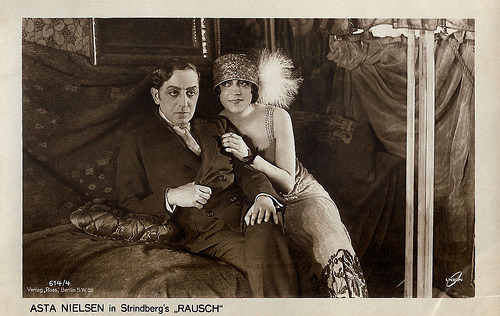
German postcard by Ross Verlag, no. 614/4. Photo: Union. Publicity still for Rausch/Intoxication (Ernst Lubitsch, 1919) with Asta Nielsen and Karl Meinhardt.
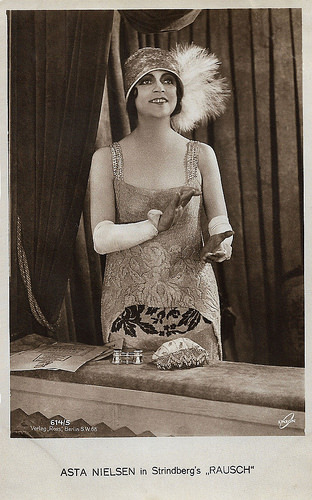
German postcard by Ross Verlag, no. 614/5. Photo: Union. Publicity still for Rausch/Intoxication (Ernst Lubitsch, 1919) with Asta Nielsen .
Sources: Filmportal.de (German), Wikipedia (English and German) and IMDb.

German postcard by Ross Verlag, no. 614/1. Photo: Union. Publicity still for Rausch/Intoxication (Ernst Lubitsch, 1919) with Asta Nielsen and Alfred Abel .

German postcard by Ross Verlag, no. 614/2. Photo: Union. Publicity still for Rausch/Intoxication (Ernst Lubitsch, 1919) with Asta Nielsen and Carl Meinhardt.
Suspected of manslaughter
During the First World War, Asta Nielsen met Frida Strindberg, playwright August Strindberg's former wife, in New York City during an American trip. Strindberg wanted to have Rausch filmed by the Fox studio. Asta Nielsen , who was stuck in New York due to the sea blockade, agreed to take over the lead role for financial reasons. However, the project was abandoned before filming had begun, according to German Wikipedia because of the working conditions at Fox.
After the war, theatre director Carl (or Karl) Meinhard resumed the idea of the Strindberg film adaptation, especially since Rausch had a successful run at German theatres. He persuaded Nielsen, who was then living in Copenhagen, to take on the lead role, while he himself took a supporting role in the film. It was Nielsen's first film after the war and also the only one that brought her together with Ernst Lubitsch .
Alfred Abel played the author Gaston, who finally succeeds as a dramatist in Paris at the turn of the 20th Century. He falls in love with Henriette ( Asta Nielsen ), the wife of his friend Adolph (Carl Meinhard). In the rush of his of feelings, he leaves his wife Jeanne (Grete Diercks) and their little daughter Marion.
Marion dies by an unfortunate accident and Gaston and Jeanne are suspected of manslaughter. Both accuse each other - Gaston in turn becomes a social outsider and is both professionally and privately increasingly unsuccessful. In the end, it turns out that Marion has died a natural death. Gaston and Jeanne are finally going their separate ways.
During the filming in the Berlin Filmatelier Chausseestraße, it came again and again to differences of opinion between Ernst Lubitsch , scriptwriter Hanns Kräly and Asta Nielsen . Nevertheless, Nielsen described in her 1946 autobiography Die schweigende Muse (The Silent Muse) the shooting as "a happy collaboration with Lubitsch", among other things, because he understood actors and possessed even at that time "excellent ... skills as a director".
Cinematographer of Rausch was Karl Freund. The sets were designed by Rochus Gliese and probably also by Paul Leni. The latter was not officially credited as a set designer but the National Film Archive in London has in its collection designs by Leni for the film. Rausch premiered on 1 August 1919 in the U.T. Kurfürstendamm in Berlin and in Munich.

German postcard by Ross Verlag, no. 614/4. Photo: Union. Publicity still for Rausch/Intoxication (Ernst Lubitsch, 1919) with Asta Nielsen and Karl Meinhardt.

German postcard by Ross Verlag, no. 614/5. Photo: Union. Publicity still for Rausch/Intoxication (Ernst Lubitsch, 1919) with Asta Nielsen .
Sources: Filmportal.de (German), Wikipedia (English and German) and IMDb.
Published on June 02, 2018 22:00
June 1, 2018
Madame DuBarry (1919)
Ernst Lubitsch's spectacular costume drama Madame DuBarry (1919) is an operatic version of the life, loves and death of the legendary 18th-century French courtesan. Pola Negri plays DuBarry, who sleeps her way from a worker in a Paris hat shop to to the court of King Louis XV, ultimately becoming his mistress. A cast-of-thousands spectacle, it got both its star and its director noticed by Hollywood.
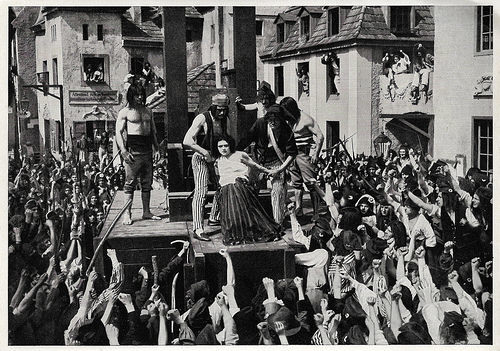
German collectors card by Ross Verlag in the series Vom Werden deutscher Filmkunst - Der Stumme Film, picture no. 67, group 40. Photo: Ufa. Publicity still for Madame Dubarry (Ernst Lubitsch, 1919). Caption: Pola Negri as Madame Dubarry, execution on the market square in Paris.
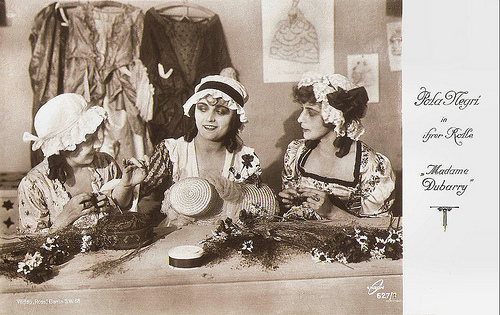
German postcard by Ross Verlag, no. 627/1. Photo: Union. Pola Negri in Madame Dubarry (Ernst Lubitsch, 1918).
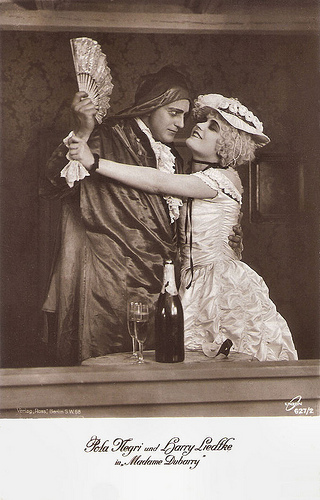
German postcard by Ross Verlag, Berlin, no. 627/2, 1919-1924. Photo: Union. Publicity still for Madame DuBarry (Ernst Lubitsch, 1919) with Pola Negri and Harry Liedtke .
Victim of the Reign of Terror
Ernst Lubitsch 's Madame Dubarry is a historical epic which opened as the premiere attraction of Berlin's impressive Zoopalast theatre on in 1919.
Writers Norbert Falk and Hanns Kraly tell the infamous story of Jeanne Becu, her rise to power's easily-swayed side, and in the end her ultimate fate at the hands of the Reign of Terror.
Pola Negri plays the milliner’s apprentice (in the film named Jeanne Marie Vaubernier), who has come to Paris from the country. Harry Liedtke plays her first love, Armand De Foix.
In a deal to save her next lover, Count DuBarry (Karl Platen), from financial ruin, the Parisian milliner's maid alias Madame DuBarry ( Pola Negri ) becomes the influential mistress of the reigning French king, Louis XV ( Emil Jannings ).
However, this relation is much to the dismay of the Minister of State and Finance, Choiseul ( Reinhard Schünzel ). This brilliant schemer had planned for his sister, the Duchesse de Grammont, to become the Queen of France. Choiseul thus starts a campaign to turn the people against the monarch and his new mistress.
Jeanne soon becomes a symbol for the extravagance of the much-hated aristocracy. When the king dies, Jeanne is ousted by the angry masses and she becomes one of the victims of the Reign of Terror during the French Revolution.
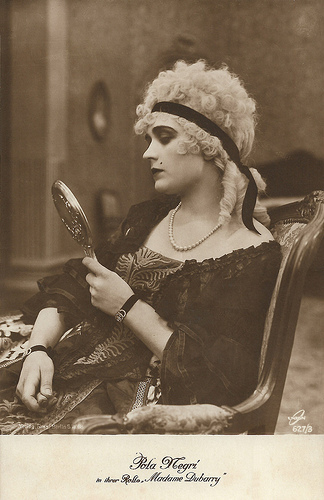
German postcard by Ross Verlag, no. 627/3. Photo: Union. Pola Negri in Madame Dubarry (Ernst Lubitsch, 1918).
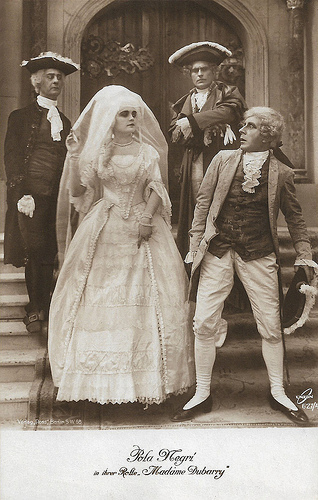
German postcard by Ross Verlag, no. 627/4. Photo: Union Film. Pola Negri in Madame DuBarry (Ernst Lubitsch, 1919). By marrying the aristocrat Guillaume DuBarry (Karl Platen), Jeanne will be accepted at the Royal Court and become Louis XV's mistress. Back right on this card DuBarry's brother Jean (Eduard von Winterstein) who concocted the plan.
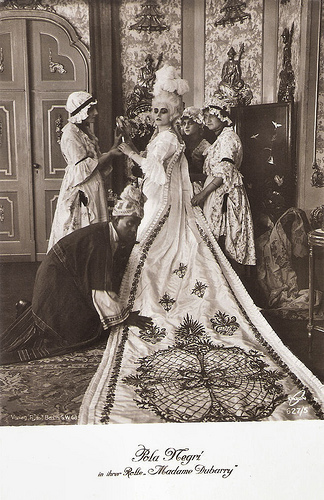
German postcard by Ross Verlag, no. 627/5. Photo: Union Film. Pola Negri in Madame DuBarry (Ernst Lubitsch, 1919).
Far from historical accuracy
Madame DuBarry (1919) had everything: sex, intrigue, war, violence. Shot in part at Frederick the Great’s Sans Souci palace in Potsdam and part in the mammoth film studio of the Ufa formed in 1917, Madame Dubarry displays all the delights of French life at Versailles.
The film was a success in both Europe (except in France) and the U.S., where it was released as Passion, and successfully re-issued in 1928. It was one of the greatest triumphs of Pola Negri .
Negri's flirtatious Madame DuBarry is both comical and sympathetic. Emil Jannings is also excellent as a lecherous, bombastic King Louis XV. Harry Liedtke plays Jeanne's first love, the student Armand de Foix.
Madame DuBarry (1919) was directed by Ernst Lubitsch , written by Norbert Falk and Hanns Kräly. It strays far from historical accuracy, but the narrative is at least coherent.
In reality, King Louis XV died 15 years before the beginning of the French Revolution and Madame DuBarry was long gone from Versailles by the time of the storming of the Bastille. She was 50 when she was executed during the Reign of Terror.
Despite these flaws, Chuck Reilly reviews at IMDb , "the gigantic mob scenes and the final shots of poor Pola being carted off to the guillotine are well-staged and resonate even with modern viewers".
Shari Kizirian at Senses of Cinema : "From the first frame, Pola Negri charms us as Jeanne. Delightfully mischievous, she has a girlish way of getting what she wants. First, seeking someone to tote the hat she is delivering, she catches a stranger’s eye. Cut, and she’s leading him with her parcel in tow toward her true destination, her boyfriend’s place. Next, Sunday lunch with an aristocrat. She chooses the don over her commoner boyfriend, by counting, and then quickly recounting, the ribbons on her dress. Her ultimate prize? A pedicure from a king. When she commands the smitten Louis to sit back down, keeping him from the business of the realm, she exercises exceptional power for a grisette."
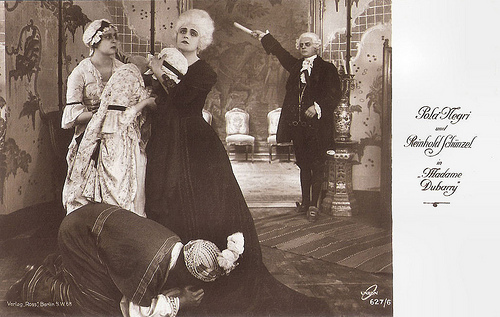
German postcard by Ross Verlag, no. 627/6. Photo: Union Film. Publicity still of Reinhold Schünzel and Pola Negri in Madame DuBarry (Ernst Lubitsch, 1919). After the death of king Louis XV ( Emil Jannings ), his minister Choiseul (Schünzel) chases DuBarry (Negri) from the Royal palace.
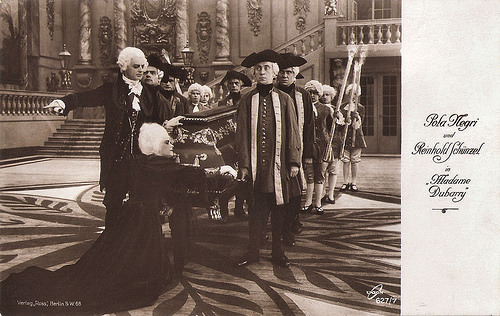
German postcard by Ross Verlag, Berlin, no. 627/7. Photo: Union Film. Publicity still of Reinhold Schünzel and Pola Negri in Madame DuBarry (Ernst Lubitsch, 1919).
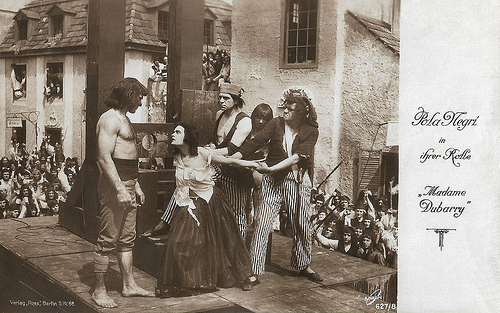
German postcard by Ross Verlag, no. 627/8. Photo: Union. Pola Negri in Madame Dubarry (Ernst Lubitsch, 1918).
Sources: Shari Kizirian (Senses of Cinema), Hal Erickson (AllMovie), Chuck Reilly (IMDb), Filmportal.de, Wikipedia and IMDb.

German collectors card by Ross Verlag in the series Vom Werden deutscher Filmkunst - Der Stumme Film, picture no. 67, group 40. Photo: Ufa. Publicity still for Madame Dubarry (Ernst Lubitsch, 1919). Caption: Pola Negri as Madame Dubarry, execution on the market square in Paris.

German postcard by Ross Verlag, no. 627/1. Photo: Union. Pola Negri in Madame Dubarry (Ernst Lubitsch, 1918).

German postcard by Ross Verlag, Berlin, no. 627/2, 1919-1924. Photo: Union. Publicity still for Madame DuBarry (Ernst Lubitsch, 1919) with Pola Negri and Harry Liedtke .
Victim of the Reign of Terror
Ernst Lubitsch 's Madame Dubarry is a historical epic which opened as the premiere attraction of Berlin's impressive Zoopalast theatre on in 1919.
Writers Norbert Falk and Hanns Kraly tell the infamous story of Jeanne Becu, her rise to power's easily-swayed side, and in the end her ultimate fate at the hands of the Reign of Terror.
Pola Negri plays the milliner’s apprentice (in the film named Jeanne Marie Vaubernier), who has come to Paris from the country. Harry Liedtke plays her first love, Armand De Foix.
In a deal to save her next lover, Count DuBarry (Karl Platen), from financial ruin, the Parisian milliner's maid alias Madame DuBarry ( Pola Negri ) becomes the influential mistress of the reigning French king, Louis XV ( Emil Jannings ).
However, this relation is much to the dismay of the Minister of State and Finance, Choiseul ( Reinhard Schünzel ). This brilliant schemer had planned for his sister, the Duchesse de Grammont, to become the Queen of France. Choiseul thus starts a campaign to turn the people against the monarch and his new mistress.
Jeanne soon becomes a symbol for the extravagance of the much-hated aristocracy. When the king dies, Jeanne is ousted by the angry masses and she becomes one of the victims of the Reign of Terror during the French Revolution.

German postcard by Ross Verlag, no. 627/3. Photo: Union. Pola Negri in Madame Dubarry (Ernst Lubitsch, 1918).

German postcard by Ross Verlag, no. 627/4. Photo: Union Film. Pola Negri in Madame DuBarry (Ernst Lubitsch, 1919). By marrying the aristocrat Guillaume DuBarry (Karl Platen), Jeanne will be accepted at the Royal Court and become Louis XV's mistress. Back right on this card DuBarry's brother Jean (Eduard von Winterstein) who concocted the plan.

German postcard by Ross Verlag, no. 627/5. Photo: Union Film. Pola Negri in Madame DuBarry (Ernst Lubitsch, 1919).
Far from historical accuracy
Madame DuBarry (1919) had everything: sex, intrigue, war, violence. Shot in part at Frederick the Great’s Sans Souci palace in Potsdam and part in the mammoth film studio of the Ufa formed in 1917, Madame Dubarry displays all the delights of French life at Versailles.
The film was a success in both Europe (except in France) and the U.S., where it was released as Passion, and successfully re-issued in 1928. It was one of the greatest triumphs of Pola Negri .
Negri's flirtatious Madame DuBarry is both comical and sympathetic. Emil Jannings is also excellent as a lecherous, bombastic King Louis XV. Harry Liedtke plays Jeanne's first love, the student Armand de Foix.
Madame DuBarry (1919) was directed by Ernst Lubitsch , written by Norbert Falk and Hanns Kräly. It strays far from historical accuracy, but the narrative is at least coherent.
In reality, King Louis XV died 15 years before the beginning of the French Revolution and Madame DuBarry was long gone from Versailles by the time of the storming of the Bastille. She was 50 when she was executed during the Reign of Terror.
Despite these flaws, Chuck Reilly reviews at IMDb , "the gigantic mob scenes and the final shots of poor Pola being carted off to the guillotine are well-staged and resonate even with modern viewers".
Shari Kizirian at Senses of Cinema : "From the first frame, Pola Negri charms us as Jeanne. Delightfully mischievous, she has a girlish way of getting what she wants. First, seeking someone to tote the hat she is delivering, she catches a stranger’s eye. Cut, and she’s leading him with her parcel in tow toward her true destination, her boyfriend’s place. Next, Sunday lunch with an aristocrat. She chooses the don over her commoner boyfriend, by counting, and then quickly recounting, the ribbons on her dress. Her ultimate prize? A pedicure from a king. When she commands the smitten Louis to sit back down, keeping him from the business of the realm, she exercises exceptional power for a grisette."

German postcard by Ross Verlag, no. 627/6. Photo: Union Film. Publicity still of Reinhold Schünzel and Pola Negri in Madame DuBarry (Ernst Lubitsch, 1919). After the death of king Louis XV ( Emil Jannings ), his minister Choiseul (Schünzel) chases DuBarry (Negri) from the Royal palace.

German postcard by Ross Verlag, Berlin, no. 627/7. Photo: Union Film. Publicity still of Reinhold Schünzel and Pola Negri in Madame DuBarry (Ernst Lubitsch, 1919).

German postcard by Ross Verlag, no. 627/8. Photo: Union. Pola Negri in Madame Dubarry (Ernst Lubitsch, 1918).
Sources: Shari Kizirian (Senses of Cinema), Hal Erickson (AllMovie), Chuck Reilly (IMDb), Filmportal.de, Wikipedia and IMDb.
Published on June 01, 2018 22:00
May 31, 2018
Die Puppe (1919)
Ernst Lubitsch's Die Puppe/The Doll (1919) is a romantic fantasy, starring Ossi Oswalda. This charming film is loosely based on the short story by E.T.A. Hoffmann, which also inspired the ballet Coppélia. The great charm of Die Puppe is its mood of fairy-tale unreality.
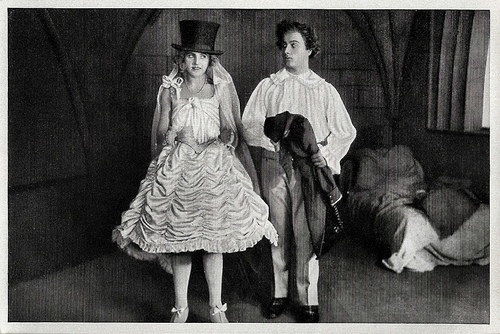
German collectors card by Ross Verlag in the series Vom Werden deutscher Filmkunst - Der Stumme Film, picture no. 117, group 39. Photo: Union. Publicity still for Die Puppe/The Doll (Ernst Lubitsch, 1919). Caption: With Die Puppe/The Doll, Lubitsch created a completely new type of comedy for the screen.
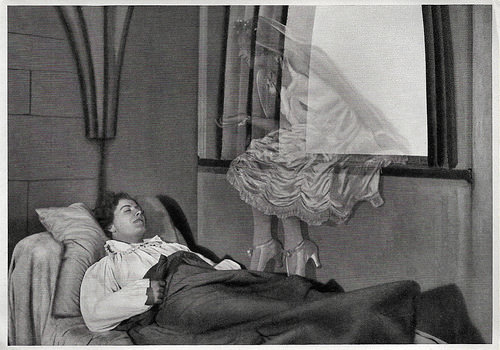
German collectors card by Ross Verlag in the series Vom Werden Deutscher Filmkunst - Der Stumme Film, no. 164, Group 40. Photo: Ufa. Publicity still for Die Puppe/The Doll (Ernst Lubitsch, 1919). Caption: From the film Die Puppe. Trick shot. Ossi Oswalda appears in Hermann Thimig 's dream.
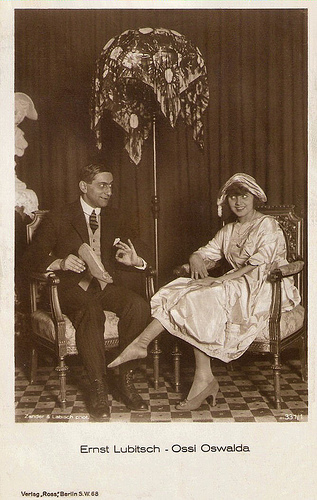
Ernst Lubitsch and Ossi Oswalda . German postcard by Ross Verlag, Berlin, no. 337/1, 1919-1924. Photo: Zander & Labisch.
A special service for bachelors, widowers and misogynists
In the opening shot of Die Puppe/The Doll, Ernst Lubitsch sets up a doll's house against a stylised backdrop. A close-up of this model then dissolves into a full-sized version of the same stylised setting, from which emerge actors dressed as dolls. From this point onward, the entire film is staged on highly stylised sets.
The old Baron von Chanterelle (Max Kronert) has no family except for his gormless nephew Lancelot ( Hermann Thimig ). He wants to preserve his family line, so he forces Lancelot to choose one of the village maidens to wed.
Lancelot flees to a monastery to escape the forty eager maidens. The Baron offers his nephew a dowry of 300,000 francs to get married. But Lancelot is afraid of women.
The prior (Jacob Tiedtke) shows him an advertisement from the doll-maker Hilarius (Victor Janson), who offers a special service 'for bachelors, widowers and misogynists': a life-size clockwork girl! Lancelot decides to marry the mechanical bride, collect the dowry, then stash the doll in the attic.
Hilarius has just finished making a replica of his pretty daughter Ossi ( Ossi Oswalda ). The clockwork girl has a control panel on her back and a crank to wind her up.
The doll-maker's young apprentice (Gerhard Ritterband) accidentally breaks the arm of the doll and convinces the real Ossi to mimic the doll. Lancelot buys her, thinking she is a doll, and takes her back to the monastery, where they are wed.
Ernst Lubitsch once wrote to his biographer Herman G. Weinberg that he considered Die Puppe and Die Austernprinzessin/The Oyster Princess (1919) as his most outstanding comedies produced in Germany before he departed for Hollywood to make Rosita (1923).
The great charm of Die Puppe is its mood of fairy-tale unreality. The coachman's horses are played by men in pantomime-horse costumes. A cat and a rooster are played by cut-out figures. The moon has a human face.
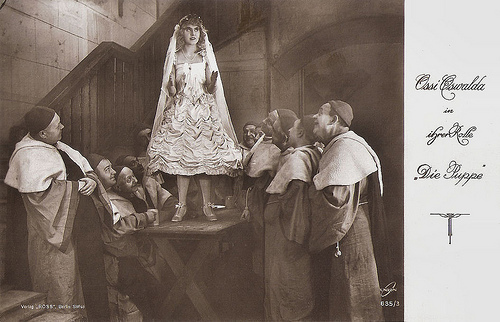
German postcard by Ross Verlag, Berlin, no. 635/3 1919-1924. Photo: Union. Publicity still for Die Puppe/The Doll (Ernst Lubitsch, 1919) with Ossi Oswalda
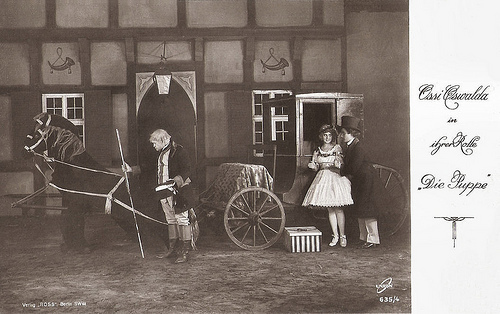
German postcard by Ross Verlag, Berlin, no. 635/4 1919-1924. Photo: Union. Publicity still for Die Puppe/The Doll (Ernst Lubitsch, 1919) with Ossi Oswalda and Hermann Thimig .
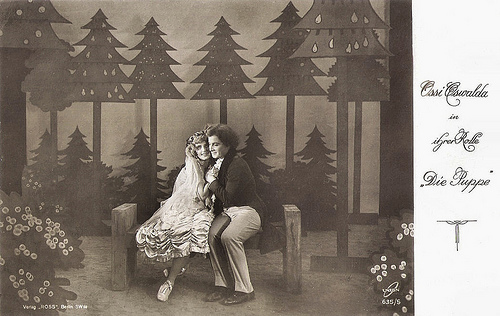
German postcard by Ross Verlag, Berlin, no. 635/5 1919-1924. Photo: Union. Publicity still for Die Puppe/The Doll (Ernst Lubitsch, 1919) with Ossi Oswalda and Hermann Thimig .
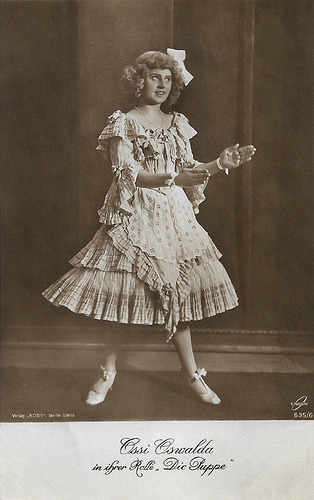
German postcard by Ross Verlag, Berlin, no. 635/6. Photo: Union. Ossi Oswalda in Die Puppe/The Doll (Ernst Lubitsch, 1919).
Sources: Will Gilbert (IMDb), Wikipedia and IMDb.

German collectors card by Ross Verlag in the series Vom Werden deutscher Filmkunst - Der Stumme Film, picture no. 117, group 39. Photo: Union. Publicity still for Die Puppe/The Doll (Ernst Lubitsch, 1919). Caption: With Die Puppe/The Doll, Lubitsch created a completely new type of comedy for the screen.

German collectors card by Ross Verlag in the series Vom Werden Deutscher Filmkunst - Der Stumme Film, no. 164, Group 40. Photo: Ufa. Publicity still for Die Puppe/The Doll (Ernst Lubitsch, 1919). Caption: From the film Die Puppe. Trick shot. Ossi Oswalda appears in Hermann Thimig 's dream.

Ernst Lubitsch and Ossi Oswalda . German postcard by Ross Verlag, Berlin, no. 337/1, 1919-1924. Photo: Zander & Labisch.
A special service for bachelors, widowers and misogynists
In the opening shot of Die Puppe/The Doll, Ernst Lubitsch sets up a doll's house against a stylised backdrop. A close-up of this model then dissolves into a full-sized version of the same stylised setting, from which emerge actors dressed as dolls. From this point onward, the entire film is staged on highly stylised sets.
The old Baron von Chanterelle (Max Kronert) has no family except for his gormless nephew Lancelot ( Hermann Thimig ). He wants to preserve his family line, so he forces Lancelot to choose one of the village maidens to wed.
Lancelot flees to a monastery to escape the forty eager maidens. The Baron offers his nephew a dowry of 300,000 francs to get married. But Lancelot is afraid of women.
The prior (Jacob Tiedtke) shows him an advertisement from the doll-maker Hilarius (Victor Janson), who offers a special service 'for bachelors, widowers and misogynists': a life-size clockwork girl! Lancelot decides to marry the mechanical bride, collect the dowry, then stash the doll in the attic.
Hilarius has just finished making a replica of his pretty daughter Ossi ( Ossi Oswalda ). The clockwork girl has a control panel on her back and a crank to wind her up.
The doll-maker's young apprentice (Gerhard Ritterband) accidentally breaks the arm of the doll and convinces the real Ossi to mimic the doll. Lancelot buys her, thinking she is a doll, and takes her back to the monastery, where they are wed.
Ernst Lubitsch once wrote to his biographer Herman G. Weinberg that he considered Die Puppe and Die Austernprinzessin/The Oyster Princess (1919) as his most outstanding comedies produced in Germany before he departed for Hollywood to make Rosita (1923).
The great charm of Die Puppe is its mood of fairy-tale unreality. The coachman's horses are played by men in pantomime-horse costumes. A cat and a rooster are played by cut-out figures. The moon has a human face.

German postcard by Ross Verlag, Berlin, no. 635/3 1919-1924. Photo: Union. Publicity still for Die Puppe/The Doll (Ernst Lubitsch, 1919) with Ossi Oswalda

German postcard by Ross Verlag, Berlin, no. 635/4 1919-1924. Photo: Union. Publicity still for Die Puppe/The Doll (Ernst Lubitsch, 1919) with Ossi Oswalda and Hermann Thimig .

German postcard by Ross Verlag, Berlin, no. 635/5 1919-1924. Photo: Union. Publicity still for Die Puppe/The Doll (Ernst Lubitsch, 1919) with Ossi Oswalda and Hermann Thimig .

German postcard by Ross Verlag, Berlin, no. 635/6. Photo: Union. Ossi Oswalda in Die Puppe/The Doll (Ernst Lubitsch, 1919).
Sources: Will Gilbert (IMDb), Wikipedia and IMDb.
Published on May 31, 2018 22:00
Paul van Yperen's Blog
- Paul van Yperen's profile
- 13 followers
Paul van Yperen isn't a Goodreads Author
(yet),
but they
do have a blog,
so here are some recent posts imported from
their feed.



